- English
- Korean
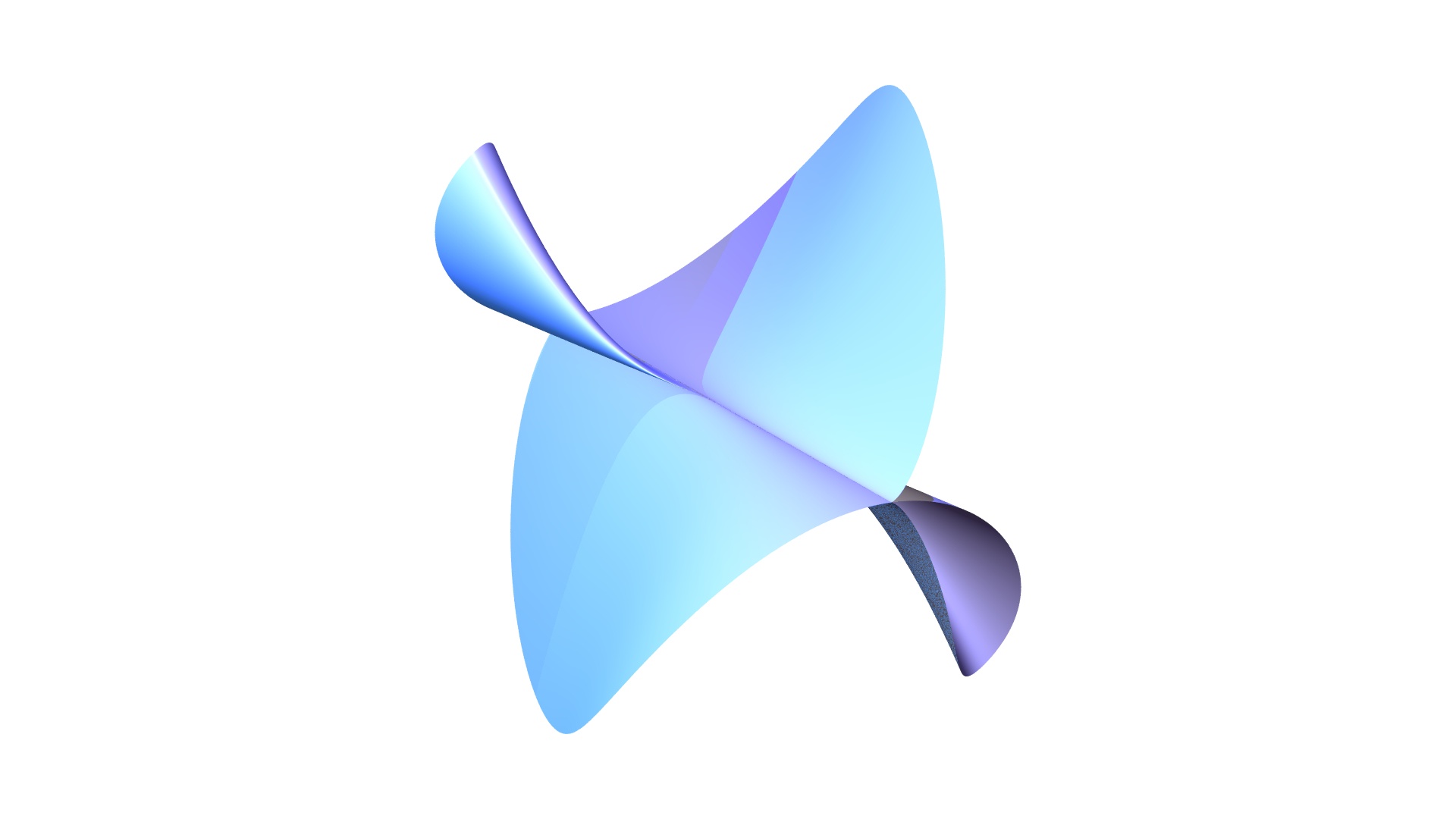
Freeness
xy3z+y5+z3=0
This surface is a representative of the species of "free" surfaces. Freeness is an algebraic property, which is not so easy to explain: roughly, it means that a free surface has singular curves, which have a very "nice" algebraic structure.
Free hypersurfaces were introduced 1980 by Kyoji Saito. Since then there has been done a lot of research revealing interesting properties of free divisors, and surprisingly free divisors pop up in quite different areas of mathematics, like deformation theory, differential geometry and combinatorics.
Author: Eleonore Faber
자유로움
xy3z+y5+z3=0
이 곡면은 "자유곡면"을 대표하는 곡면 중 하나입니다. 이 "자유로움"은 설명하기 쉽지 않은 대수학적 성질로, 개략적으로 이야기하자면 자유곡면은 아주 "좋은" 대수적 구조를 가진 특이곡선(singular curve)을 포함한다는 내용입니다.
자유 초곡면(hypersurface)은 1980년에 Kyoji Saito가 처음 생각하였고, 그 이후로 이와 관련된 자유 인자(free divisor)의 많은 재미있는 성질들이 연구되었습니다. 놀랍게도 이 자유 인자는 변형 이론(deformation theory), 미분기하와 조합론 같은 전혀 다른 수학 분야들에서도 등장하게 됩니다.
만든 이: Eleonore Faber
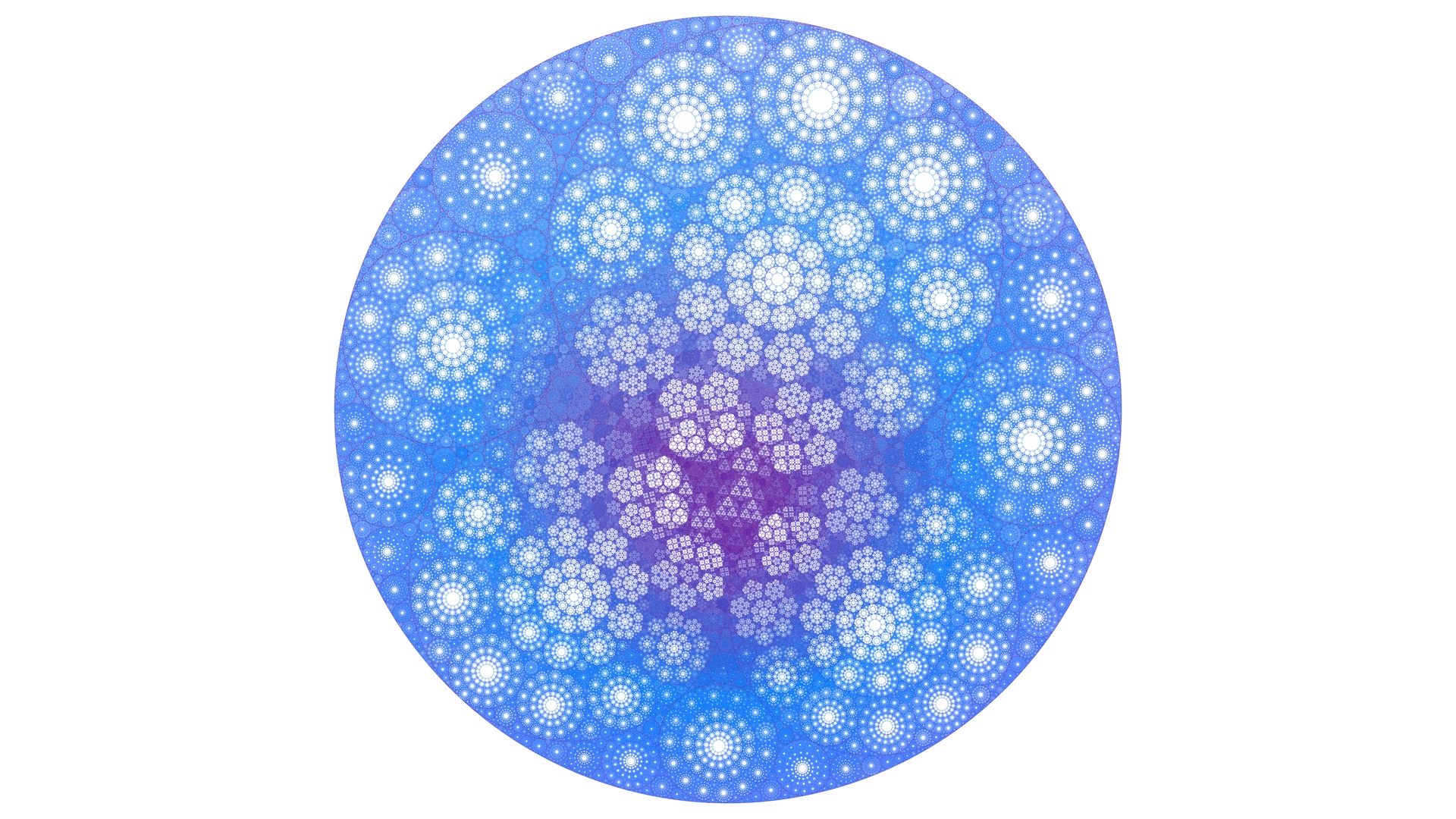
Circle Packing
Circle packing can be seen as the art of placing tangent circles on the plane, leaving as little unoccupied space as possible. The so called Apollonian Gasket recursively fills the space between tangent circles. But this method leaves large empty spaces inside the initial circles. The Steiner Chain method puts a chain of tangent circles between two circles. Here, two methods are combined and repeatedly applied.
Author: Francesco De Comité
원 채우기
원 채우기(Circle packing)는 남은 면적을 최소화하면서 평면을 서로 접하는 원으로 채워나가는 과정을 말합니다.
아폴로니안 개스킷(Apollonian Gasket)은 접하는 원 사이의 공간을 재귀적으로 채워나갑니다. 하지만 이 방식은 초기 원의 안에 큰 공간을 남기게 됩니다. 스타이너 체인(Steiner Chain) 방식은 두 원 사이에 일련의 접하는 원을 위치시킵니다. 이 그림은 두 방법을 결합하고 반복적으로 적용하여 얻어졌습니다.
만든 이: Francesco De Comité
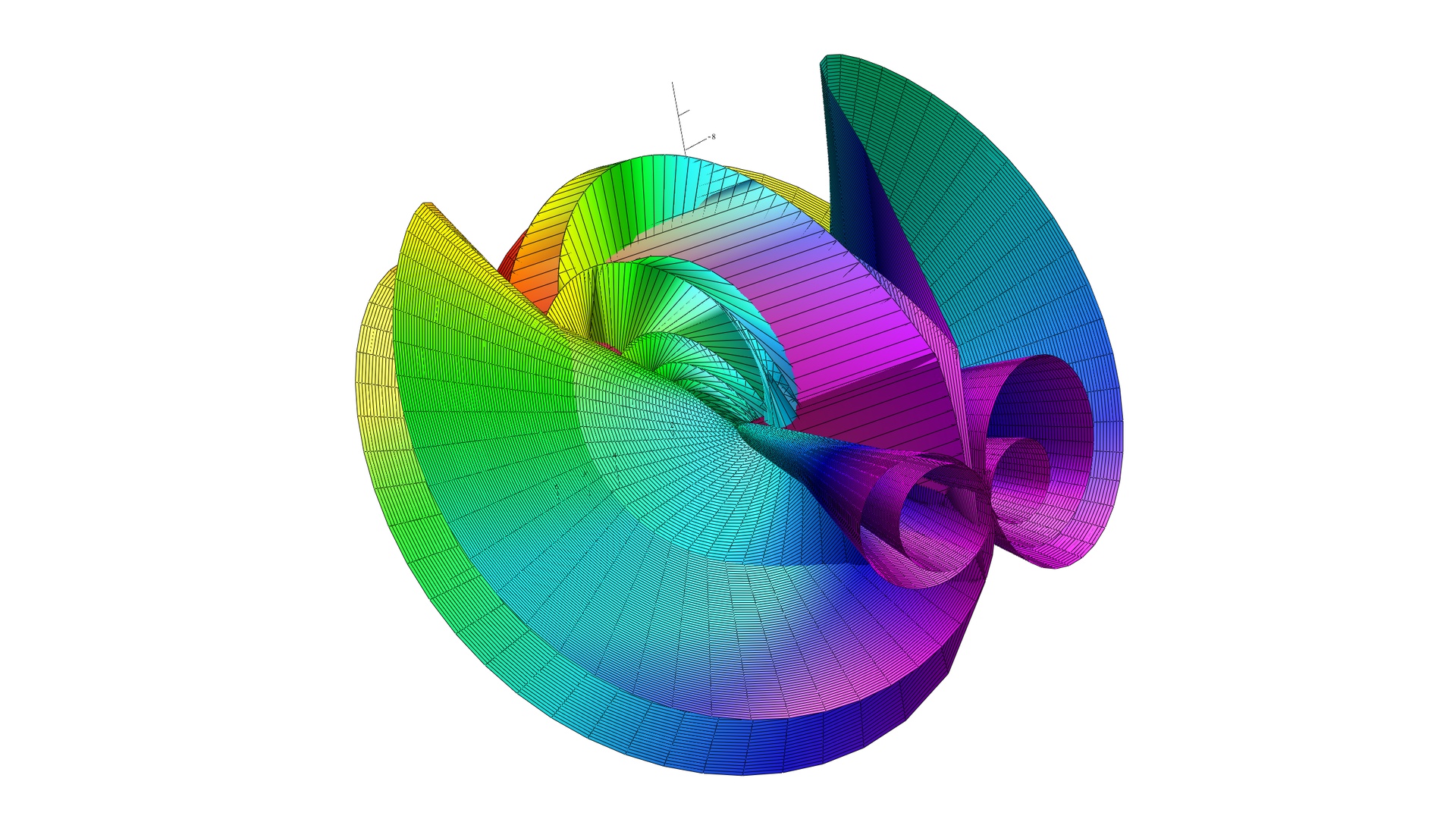
Cyclotomic Creation
This image was generated through Maple Mathematics software. The author is basically sculpting with mathematics, using as his chisel trigonometric, group and number theoretic functions (and composed functions) so as to meticulously surf texture, scale and graphical behavior.
Author: Kenneth Neil Rubenstein
원분 창조(Cyclotomic Creation)
이 이미지는 수학 소프트웨어인 메이플(Maple)로 만들어졌습니다. 이는 삼각함수, 군론과 정수론적 함수(와 이들의 합성)들을 이용해 질감, 크기와 시각적 효과를 섬세하게 조절한, 수학으로 조각한 작품입니다.
만든 이: Kenneth Neil Rubenstein
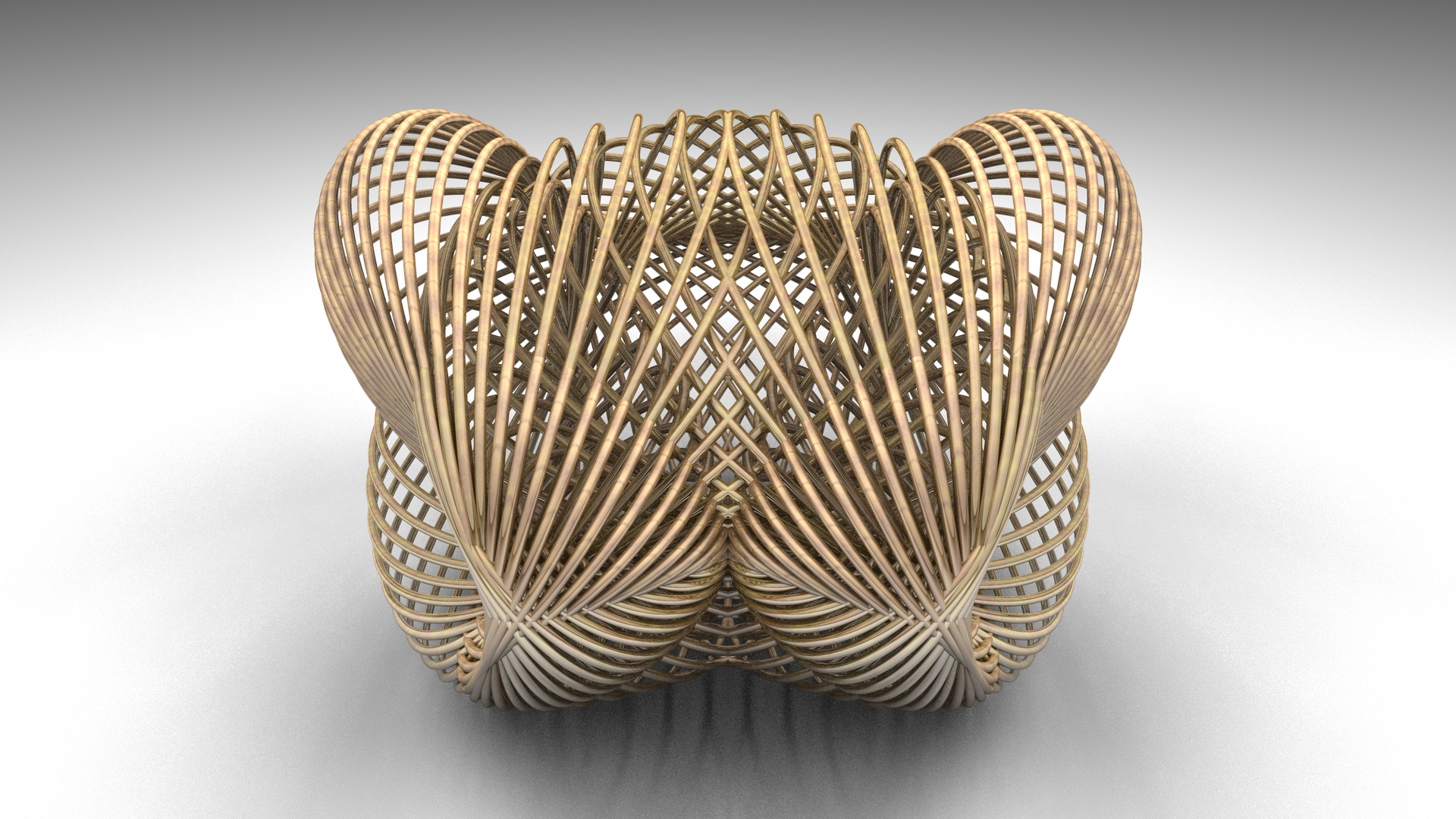
The Cardioid
The cardioid is a very current curve which can be generated in a lot of different ways: rolling a coin around another one, by reflection of sunlight into a milk pan (may be the first encounter with a not so simple mathematical object for children).
Pedoe method defines it as the envelop of a set of circles. If you rotate those circles in order to produce a 3-dimensional object, and if you try different ways to control this rotation, you can produce an infinity of very appealing structures, like this one, which inspired British milliner Gabriela Ligenza to create the first line of a 3D-printed hat.
Author: Francesco De Comité
심장형
심장형 또는 카디오이드(cardioid)라 불리는 이 곡선은 여러 가지 방법으로 만들어질 수 있습니다. 동전 하나를 다른 동전 주위에서 굴려서 만들 수 있고, 햇빛이 양동이 안에 반사되어 비칠 때 나타나기도 합니다. (아이들에게는 아마 처음 보는 간단하지 않은 수학적 대상일 것입니다.)
Pedoe의 방법은 이 심장형 곡선을 여러 원들의 포락선(envelope)으로 만들어냅니다. 이제 이 원형들을 회전시켜 3차원 대상을 만들어낼 때 여러 가지 방법으로 회전을 조절한다면, 지금 이 그림처럼 매력적인 구조들을 무한히 많이 만들어낼 수 있습니다. 이 이미지는 여성용 모자 디자이너 Gabriela Ligenza에게 영감을 주어, 3D프린터를 이용한 모자생산을 하게 하기도 하였습니다.
만든 이: Francesco De Comité
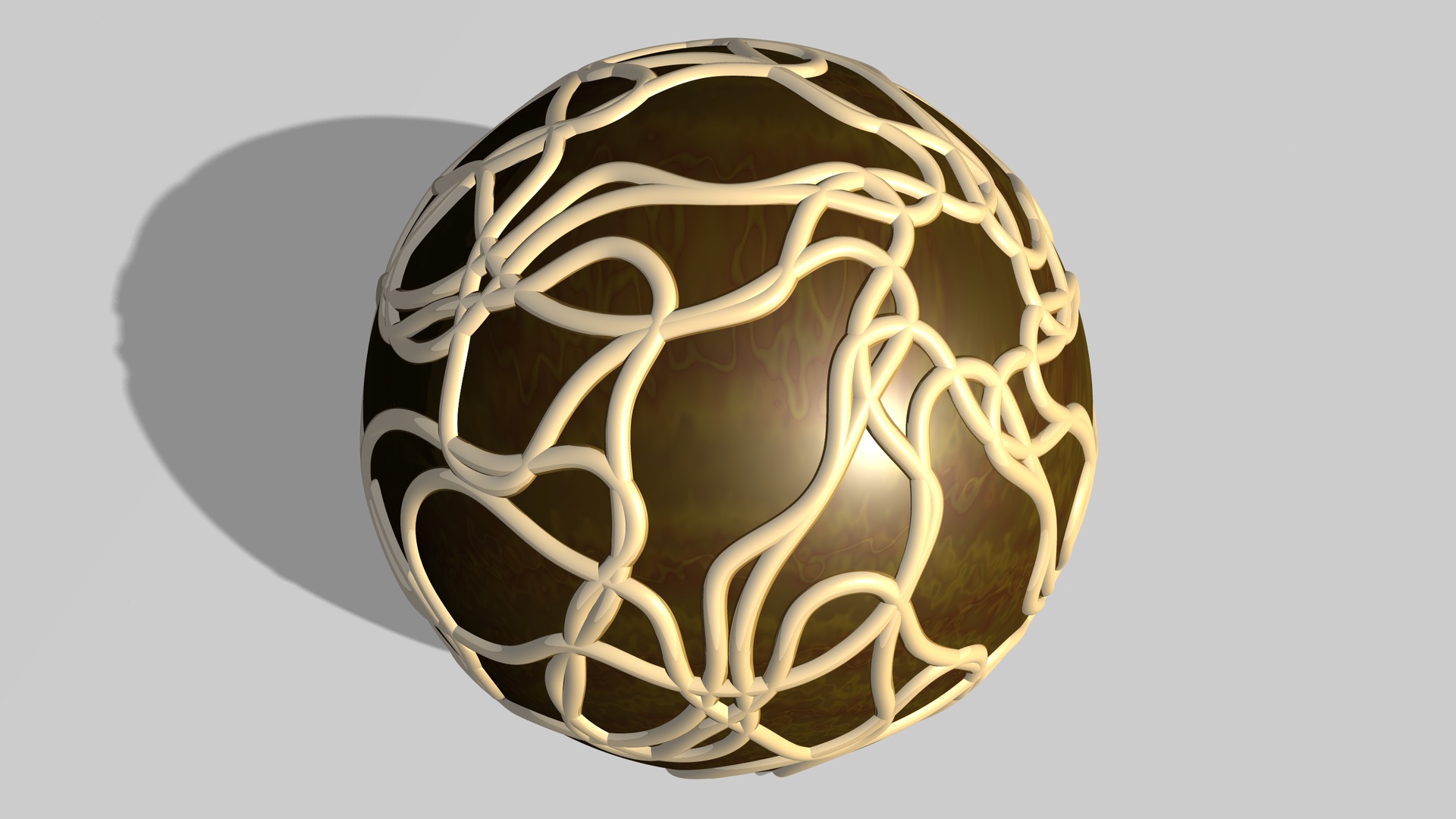
Hamiltonian Circuit
It is known, that every archimedean solid has a hamiltonian circuit lying on all of its vertices. It is not so easy to find one of those circuits.
The author succeeded in finding a 104 vertices path on a truncated icosidodecahedron (instead of 120) and then connected those 104 points with a curved line, and afterwards duplicated this path five times, with the same transformations that produces the compound of five tetrahedra from a single initial. The structure was then rotated in order to hide the less symmetric parts.
Mathematics can be beautiful, even if not perfect.
Author: Francesco De Comité
해밀턴 회로
준정다면체는 항상 모든 꼭지점을 정확히 한 번씩만 지나 제자리로 돌아오는 해밀턴 회로(Hamiltonian circuit)를 가지지만, 그 회로를 찾는 것은 쉽지만은 않습니다.
이 이미지의 제작자는 깎은 십이이십면체의 120개 꼭지점 중 104개의 꼭지점을 지나는 회로를 찾은 후, 이를 곡선으로 연결하였습니다. 그 다음 정사면체 하나로부터 시작해 정사면체 5복합체(compound of five tetrahedra)를 만들어내는 5개의 변환을 적용해, 이 곡선을 5개로 복사하였습니다. 마지막으로 비대칭적인 부분을 뒤쪽으로 돌려 보여줍니다.
비록 완벽하지 않아도, 수학은 얼마든지 아름답습니다.
만든 이: Francesco De Comité
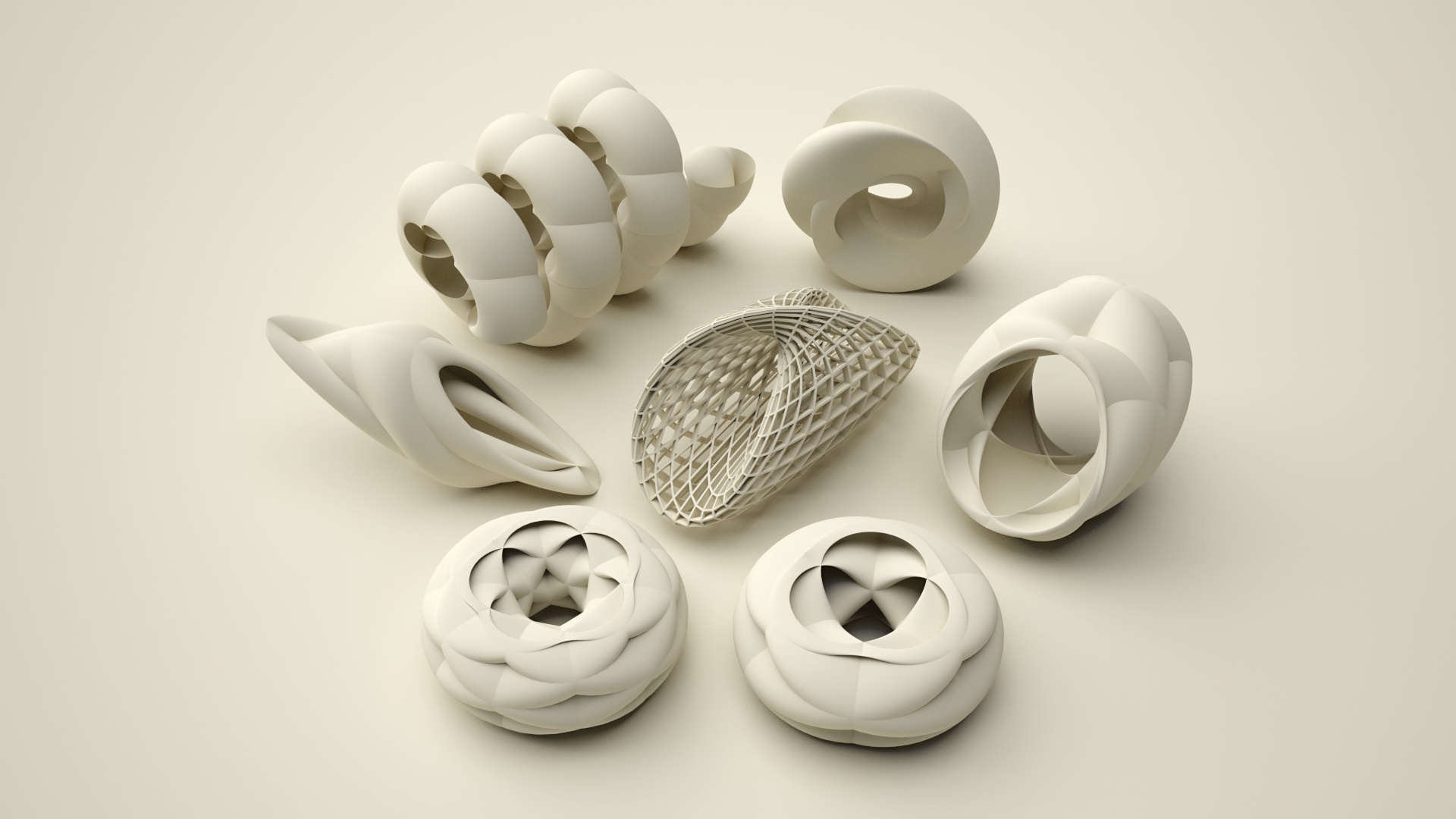
Bohemian Stars
A collection of famous and/or interesting mathematical shapes and surfaces created with the software K3DSurf, which is a program to visualize and manipulate mathematical models in three, four, five and six dimensions. It supports parametric equations and isosurfaces.
Author: Torolf Sauermann
보헤미안 스타
여기 있는 유명하거나 흥미로운 수학적 모형과 곡면들은 수학 소프트웨어 K3DSurf로 만들어졌습니다. 이 프로그램은 3, 4, 5, 6차원에 있는 수학 모델을 시각화하고 조작할 수 있도록 합니다. 또한, 매개변수 방정식과 등위곡면을 나타낼 수 있습니다.
만든 이: Torolf Sauermann
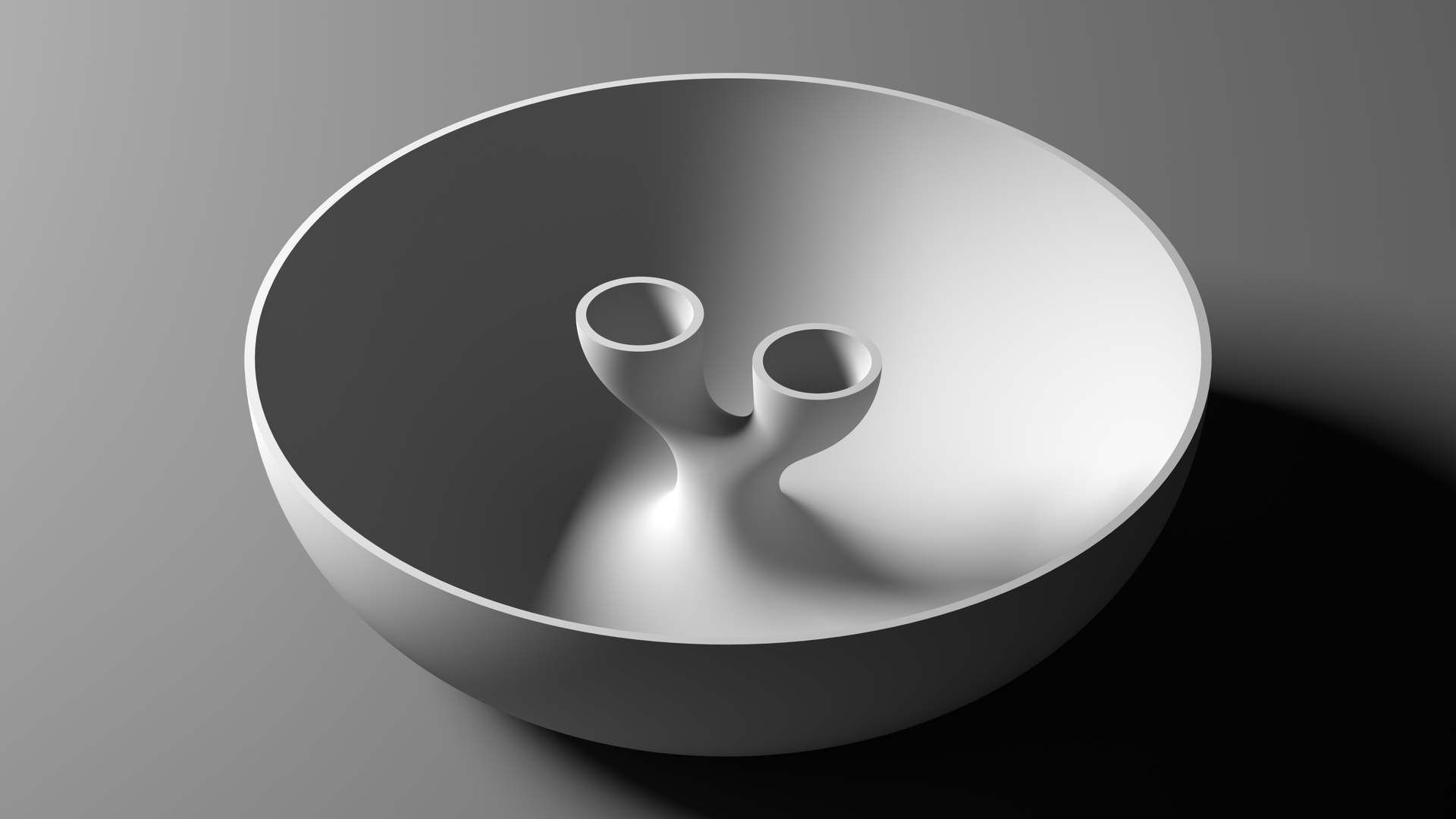
Lawson symmetric CMC surface
This is a cut-through view of a constant mean curvature surface (critical surface for the area with fixed enclosed volume) based on Lawson genus 2 minimal surface, analogous to a Delaunay torus.
It was recently discovered (2013) using Hitchin abelianization and the Dorfmeister-Pedit-Wu (DPW) Method.
Authors: Sebastian Heller, Nicholas Schmitt
Lawson의 대칭적인 상수평균곡률 곡면
상수평균곡률(constant mean curvature, CMC) 곡면은 평균곡률이 일정한 곡면으로, 같은 부피를 둘러싸는 것 중 표면적이 국소적으로 최소화되는 성질을 갖고 있습니다. 이 그림은 Lawson의 종수(genus) 2 곡면을 바탕으로 만들어진, Delaunay torus와 비슷한 CMC 곡면의 단면입니다.
이는 Hitchin abelianization과 Dorfmeister-Pedit-Wu (DPW) 방법을 적용해, 2013년에 발견되었습니다.
만든 이: Sebastian Heller, Nicholas Schmitt
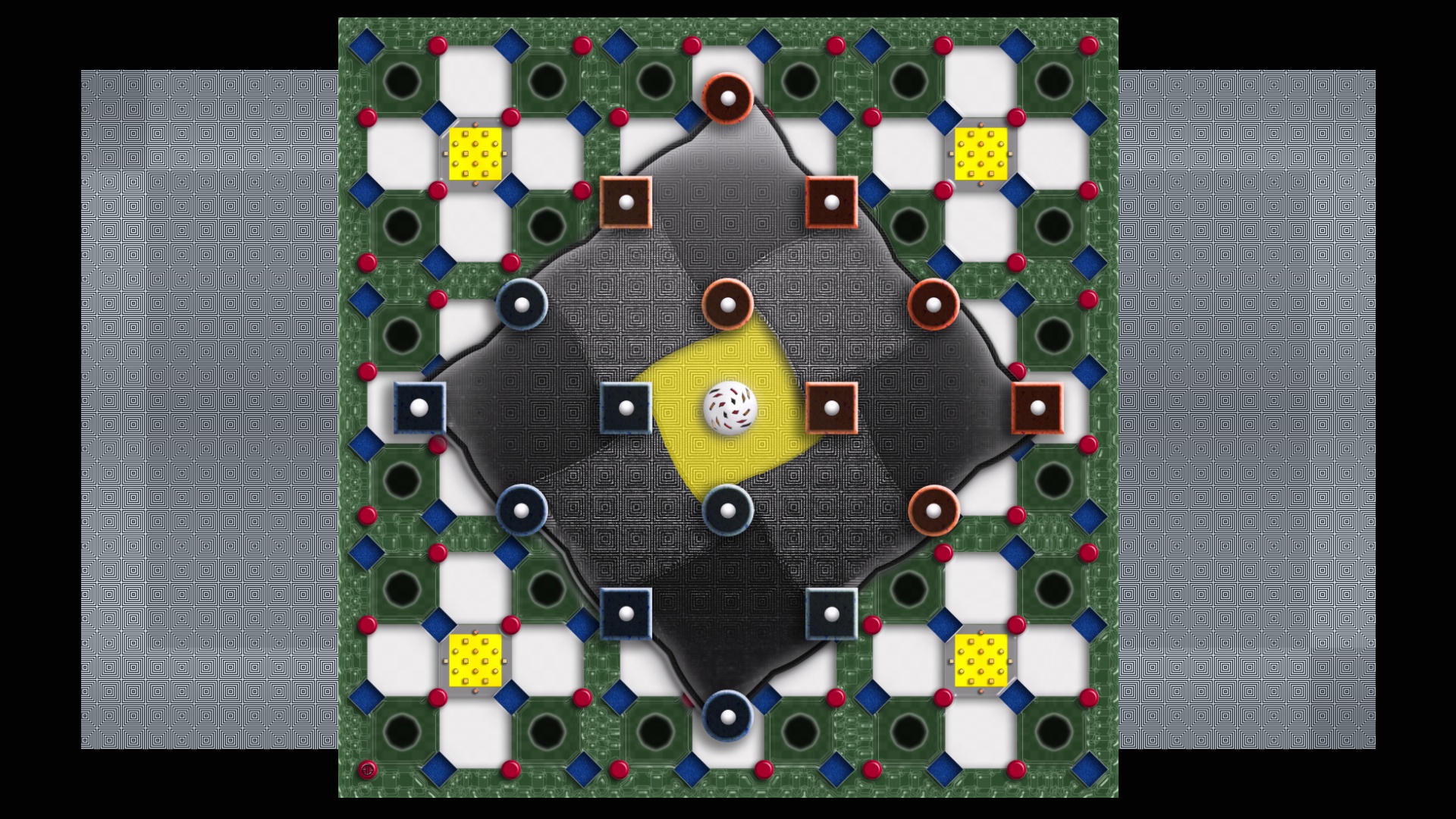
Classic Graph Theory Model 'The Shortest Route Problem'
The numerical reasoning needed to solve the 'Shortest Route Problem' has been emphasized by graphic cues of various shapes and color intended to guide the viewer thought the problem solving steps.
The specific color palette is based on the Korean traditional color palette - red, yellow and blue, plus black & white.
Author: Jean Constant
고전적인 그래프이론 모델 '최단경로 문제'
이 그림은 다양한 형태의 표식을 사용해 ‘최단경로문제’를 해결하기 위해 필요한 수리적 추론이 무엇인지 강조합니다. 또한 각 표식의 색상을 달리함으로써 문제를 해결하는 단계를 보여줍니다.
이 그림에 사용된 색상은 한국의 전통예술에 많이 사용되는 빨강, 노랑, 파랑, 흰색, 그리고 검정색입니다.
만든 이: Jean Constant
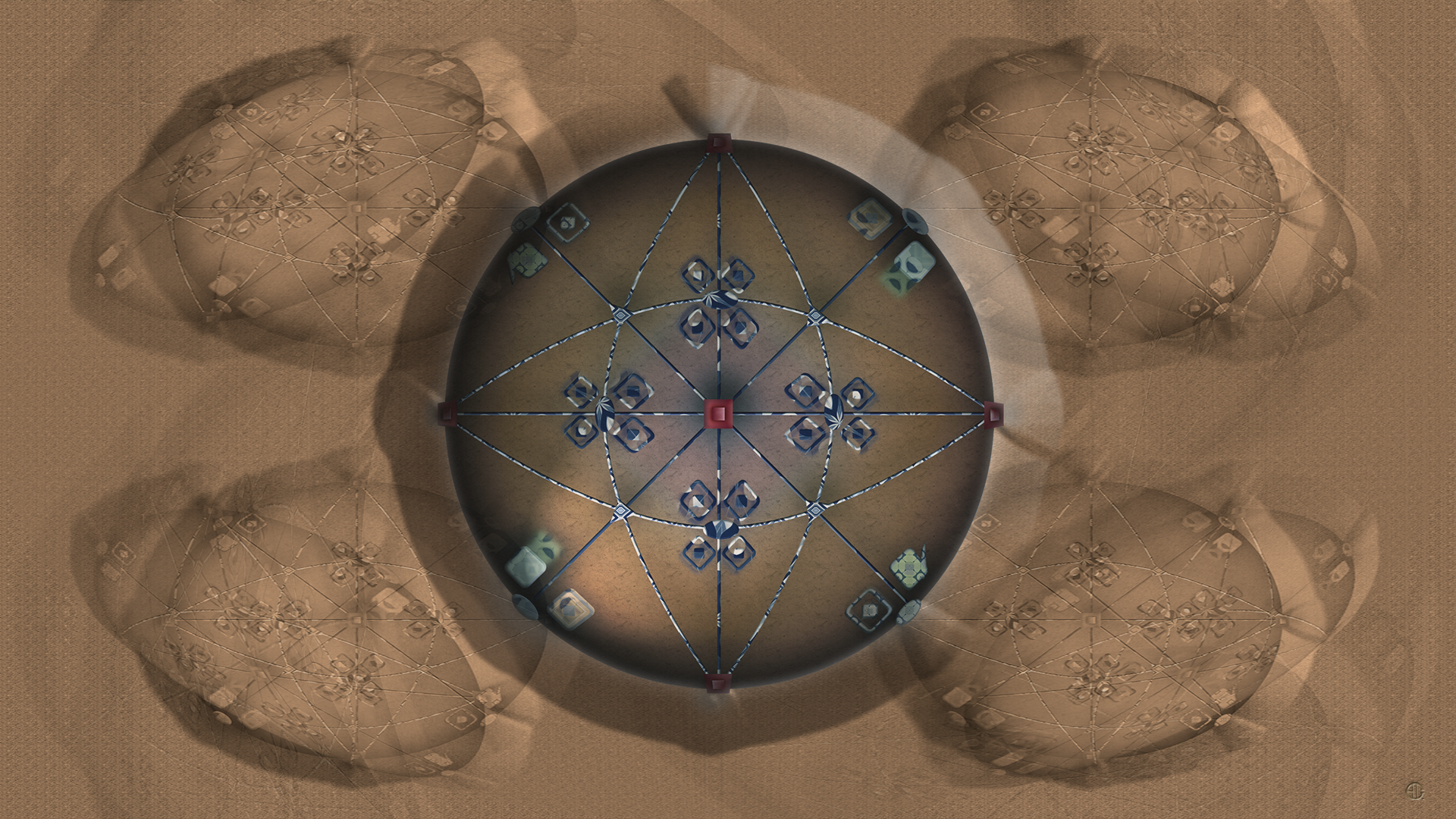
Isometric Symmetry
This is an illustration of one of the 32 crystallographic point group symmetries called isometric symmetry. A mathematical object is symmetric with respect to a given mathematical operation, if, when applied to the object, the operation preserves the property of the object. The isometric system is the most symmetrical system possible in three dimensional space.
The isometric unit cell is distinguished by four lines, called axes of threefold symmetry, about which the cell can be rotated by 120 degree without changing its appearance. Diamonds and red spinels belong to the isometric system.
Author: Jean Constant
입방대칭
이 작품은 32가지 결정대칭 중 하나인 입방대칭을 보여주고 있습니다. 수학적 대칭은 어떤 물체가 주어진 수학적 작용 하에 변하지 않고 그 형태를 보존하는 것입니다. 3차원에서 나타날 수 있는 다양한 대칭 중 입방대칭은 가장 대칭적인 시스템입니다.
입방대칭의 단위결정은 3중대칭의 축을 이루는 4개의 선으로 구분되어지며, 이 선들을 기준으로 형태의 변화 없이 120도 회전을 할 수 있습니다. 다이아몬드와 레드스피넬의 결정이 이 대칭군에 속해있습니다.
만든 이: Jean Constant
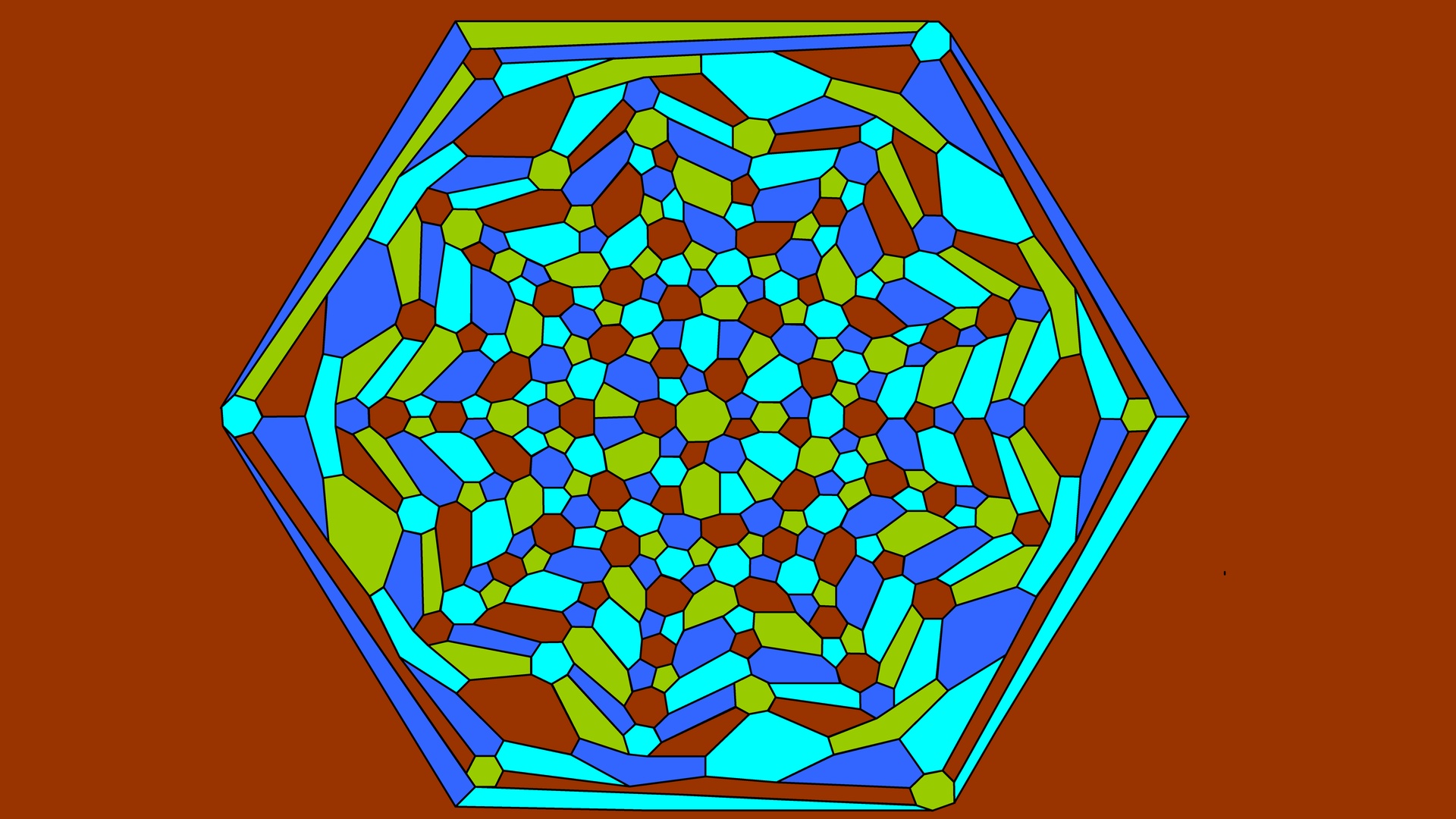
The Four Color Map
The four color map problem is to color regions of a map with at most four colors so that neighboring regions (countries) are presented in different colors. This simple problem was posed and conjectured to be true by Guthrie in 1852, although first proven in 1976 with the help of computers. The author presents the problem using only methods of the Victorian age in which the four color problem arose. The image illustrates the last of the three steps of the algorithmic proof.
Author: Ibrahim Cahit Arkut
사색 지도
“4색 문제”는 서로 인접한 두 나라는 다른 색으로 칠한다고 할 때, 최대 4가지 색만을 사용하여 모든 지도를 채색할 수 있는지를 묻는 문제입니다. 이 간단한 문제는 1852년 프랜시스 구드리(Francis Guthrie)에 의해 제시되었으며 참이라 추측되어 왔습니다.
1976년, 일리노이 대학의 아펠(Kenneth Appel)과 하켄(Wolfgang Haken)은 컴퓨터를 사용하여 ‘4색 문제’가 참이라는 것을 처음으로 증명하였습니다. Ibrahim Cahit Arkut은 문제가 처음 제기되었던 당시의 방법만을 사용한 ‘4색 문제’의 새로운 증명을 제시하였으며, 이 그림은 그 증명의 3단계 중 마지막 단계를 보여주고 있습니다.
만든 이: Ibrahim Cahit Arkut
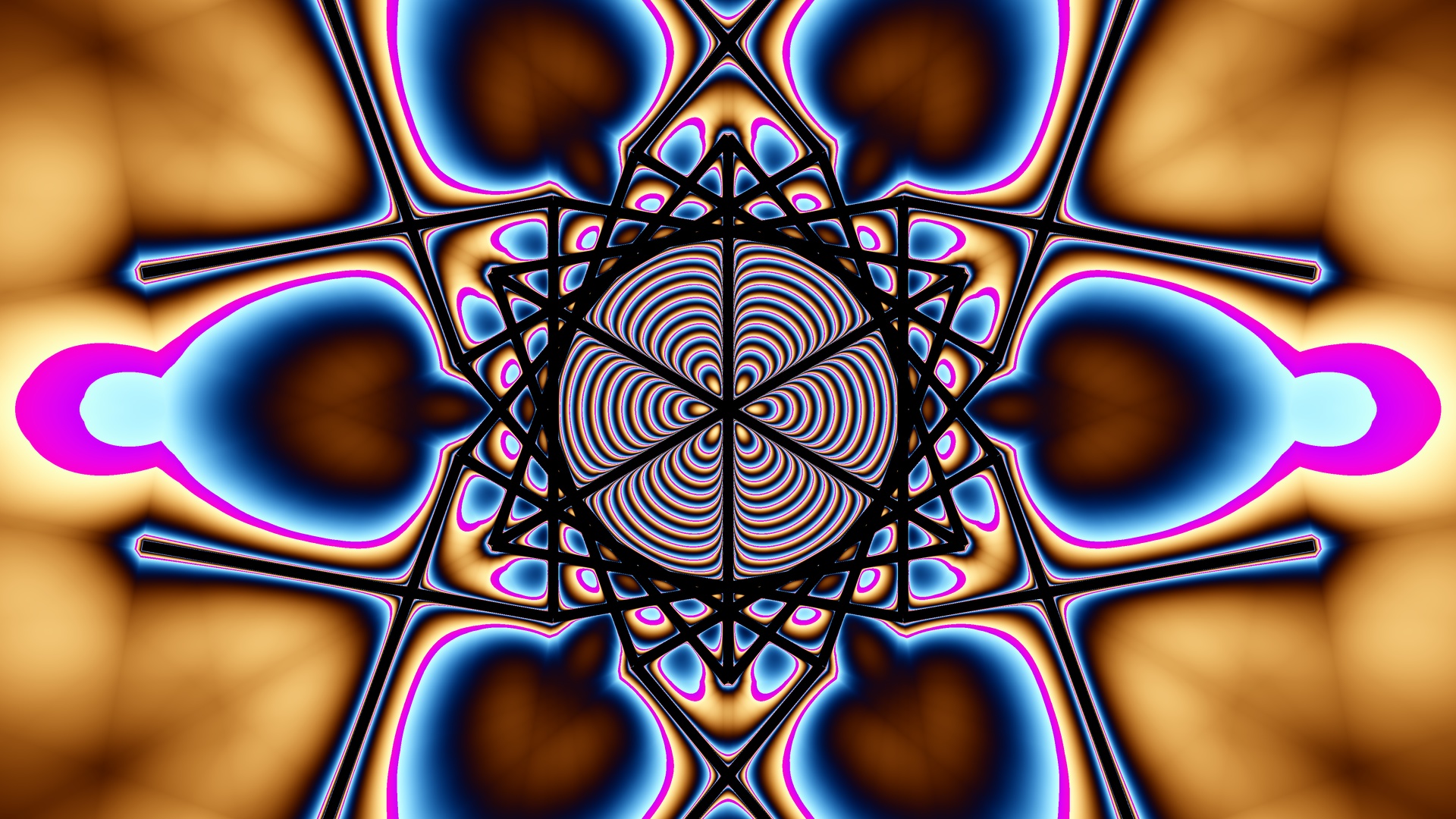
Turtle Geometry
Turtle Geometry engages students in exploring mathematical properties visually via a simple programming language. This example shows a polygonal line consisting of a series of points connected by lines with unit length. The coordinates of each point are calculated iteratively following simple rules.
The result is a beautiful figure with sixfold symmetry. By modification of the parameters interesting figures of different shape and symmetry are obtained.
Author: Christian Gaier
거북 기하
"거북 기하" 프로그램은 학생들이 간단한 프로그래밍 언어를 통해서 수학적 성질을 탐구할 수 있게 합니다. 지금 이 예는 단위길이 선분들의 끝점을 이은 사슬을 보여주고 있는데, 각각의 선분들의 끝점들은 간단한 규칙을 반복하여 하나씩 계산되었습니다.
그러면 6중 회전대칭을 가지는 다음의 아름다운 도형이 만들어집니다. 매개변수를 조절하면 다른 모양과 대칭을 가지는 흥미로운 도형들을 만들 수 있습니다.
만든 이: Christian Gaier
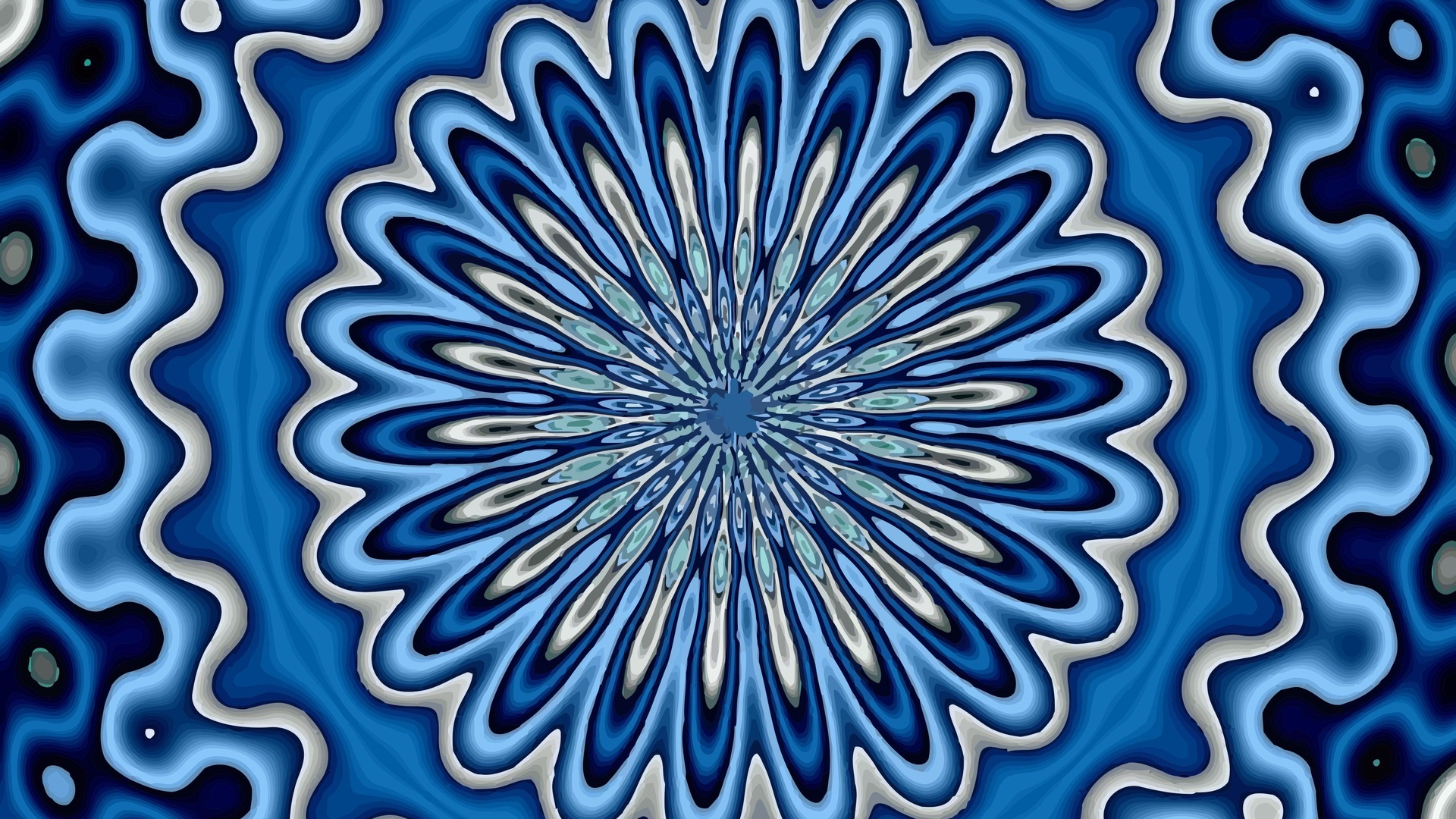
Pixel Symphony
This image is generated by a simple program based on defining the color of each pixel using polar coordinates of the actual pixel combined with random values of constants which represent the genetic code of each program cycle.
At the beginning of each cycle the program defines a coloring palette, a random path through algorithms and a genetic code composed of 24 random values. Then each pixel is elaborated by going from the center towards the border. On every pixel a kind of mathematical "symphony" is performed, the result is the color of the actual pixel.
The program SYMMETRY08 is made by the picture author and can be downloaded at www.imaginary.org.
Author: Bogdan Soban
픽셀 교향곡
이 그림은 프로그램 주기의 유전 부호(genetic code)를 나타내는 랜덤 상수와 2차원 평면 상의 픽셀 위치의 극좌표를 이용해 각각의 픽셀에 색상을 결정하는 아이디어를 결합한 프로그램을 통해 만들어졌습니다.
각 주기의 시작 시점에, 프로그램은 채색할 색상과 24개의 상수로 구성된 유전부호, 그리고 프로그램의 경로를 랜덤하게 결정합니다. 그 다음, 프로그램은 그림의 중앙에서 바깥쪽으로 이동하며 각 픽셀의 색상을 정교하게 생성합니다. 선택된 프로그램 경로에 의해 결정되는 수많은 알고리즘과 공식은 각 픽셀마다 수학적 교향곡을 써 내려갑니다. 이 그림에 그려진 실제 픽셀의 색상이 바로 “픽셀 교향곡”의 결과입니다.
이 프로그램의 이름은 SYMMETRY08이고 www.imaginary.org 에서 다운받을 수 있습니다.
만든 이: Bogdan Soban
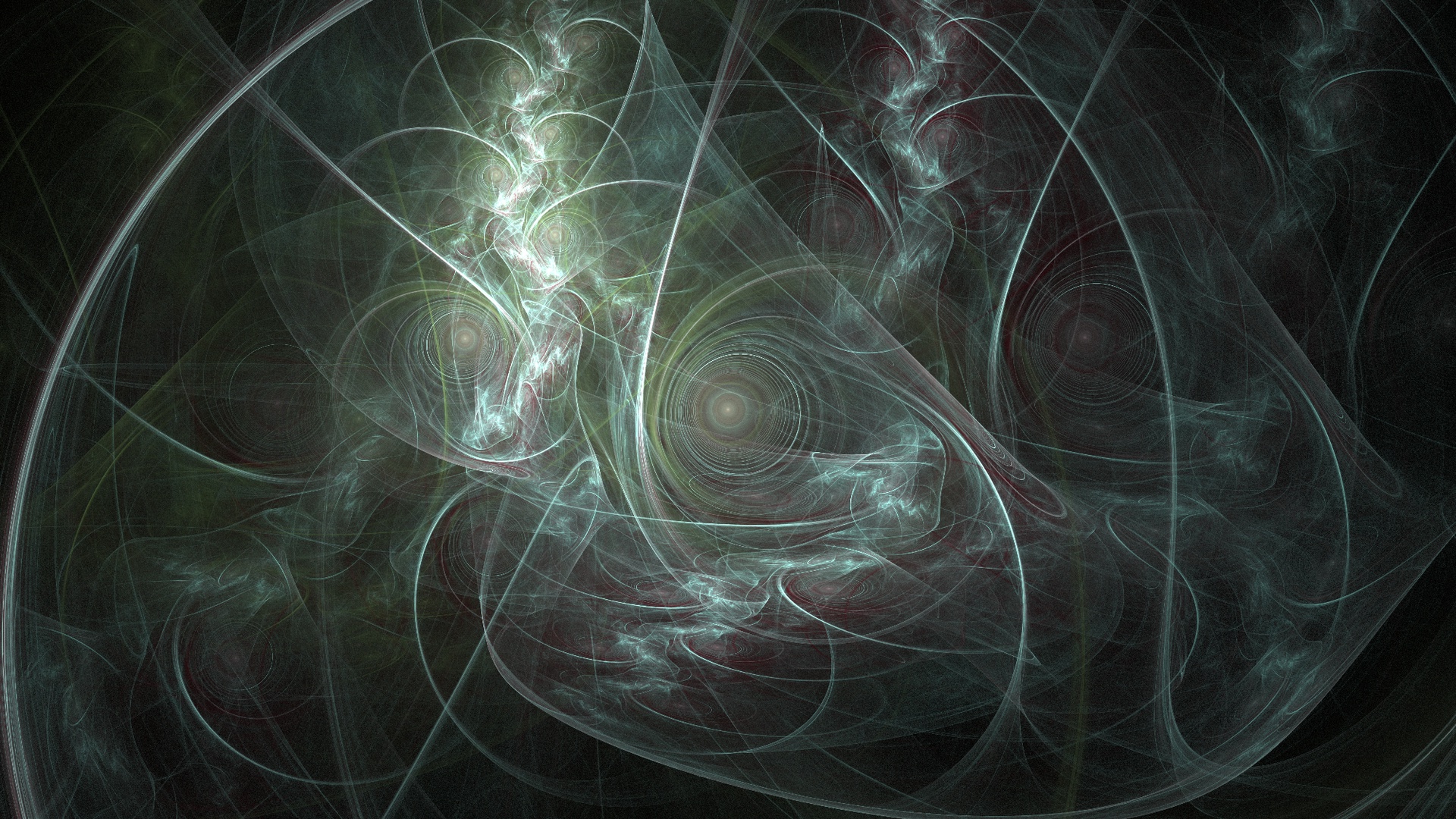
Apophysis
In 1988, Michael Barnsley developed the theory of Iterated Function Systems (IFS in short), a way of describing and generating fractals well suited for programming. The functions used were all affine transformations, and can generate objects like ferns, Sierpinski gaskets, etc.
Apophysis is a computer program, initiated by Scott Draves, which generalizes IFS by using non linear functions instead of affine ones. Its interface is quite complete and user friendly, allowing easy and fast experiments.
This picture was created using Apophysis. The program is a good illustration of what experimental mathematics can offer: fast tests and a large universe of possibilities.
Author: Francesco De Comité
Apophysis
1988년, Michael Barnsley는 프로그래밍에 적합한 프랙탈 생성 및 묘사 방법인 ‘반복 함수 시스템(Iterated Function System, IFS)’을 개발했습니다. 이 시스템에 사용된 함수는 모두 아핀(affine) 변환이었고, 양치식물, 시어핀스키 개스킷(Sierpinski gasket)과 같은 것들을 생성할 수 있습니다.
Scott Draves가 개발을 주도한 Apophysis라는 컴퓨터 프로그램은 아핀 변환 대신 비선형 함수를 사용함으로써 IFS를 일반화했습니다. 이 프로그램의 인터페이스는 사용자 친화적이고, 완벽해서 쉽고 빠르게 실험을 할 수 있도록 만들어줍니다.
이 그림은 Apophysis를 사용해 생성되었습니다. 이 프로그램은 빠른 테스트와 무한한 가능성과 같은 실험적 수학이 제공할 수 있는 것들을 잘 보여주고 있습니다.
만든 이: Francesco De Comité
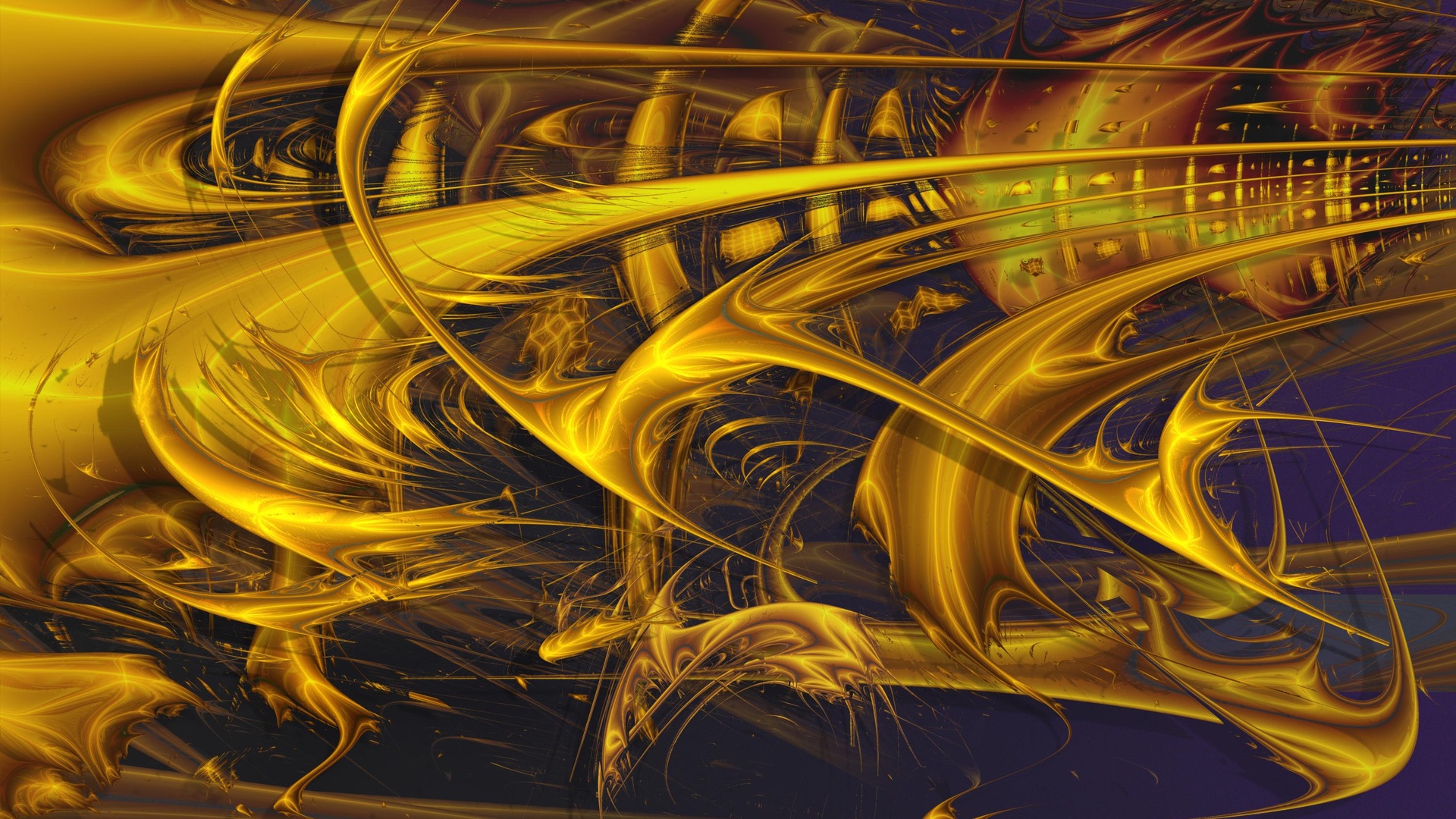
Lyapunov Play
Mario Markus of Max Planck Institute for Nutrition has used dynamical systems to study the evolution of animal populations - the change over time of food, fertility, size, etc. - with dynamics requiring the ability of reproduction to alternate quasi-periodically between two values. Such systems can show both a stable cycle and chaotic evolution depending on the fertility ability. Stability or chaos can be analysed by computing the so-called Lyapunov exponent. (Lyapunov was a Russian mathematician living at the end of the 19th century)
Markus-Lyapunov images are colour mappings of the Lyapunov exponent versus fertility, along horizontal and vertical axes. Only the stability domain is plotted; here, chaos (i.e. positive Lyapunov exponent) is rendered in dark blue. As the exponent goes from 0 to minus infinity, shades range from light to dark. At zero, the chaos threshold, the colour suddenly jumps from dark blue to a lighter shade. There is clearly much that is arbitrary in this colour mapping, and this gives an opportunity for choices based on aesthetic considerations. The picture consists of seven original Markus-Lyapunov pictures which were rebuilt and superimposed.
Author: Luc Benard
리아푸노프 플레이
막스 플랑크 영양학 연구소의 마리오 마르쿠스(Mario Markus)는 동물 개체집단의 진화를 연구하기 위해 동역학계 이론을 사용했습니다. 예를 들어 시간에 따른 먹이양, 개체군의 번식력 및 개체수 등의 변화를 연구할때, 추가적으로 집단의 생식력이 주어진 두 값 사이에서 준 주기적으로 변동한다는 조건이 주어진 경우, 동역학계 이론을 사용할 수 있습니다. 그러한 시스템에서는 집단의 생식력에 따라 안정적인 사이클과 카오스적인 진화가 함께 나타날 수 있습니다. 안정성과 카오스는 19세기 말의 러시아 수학자 이름을 딴 리아푸노프 지수라는 것을 계산함으로써 분석할 수 있습니다.
마르쿠스-리아푸노프 이미지는 가로 및 세로 축을 따라, 생식력 대 리아푸노프 지수를 색상으로 대응시킵니다. 안정성 도메인만이 그려지고, 카오스, 즉 양의 리아푸노프 지수는 암청색으로 표현됩니다. 지수가 0에서 음의 무한대로 변화할 때, 그림자는 어두워집니다. 지수가 0이면, 카오스의 임계값을 의미하고, 색은 갑자기 암청색에서 밝은 그림자로 변합니다. 이 색상을 대응시키는 방법은 임의적이기 때문에 미적 관점 및 고려에 따라 다양하게 선택할 수 있습니다. 현재의 그림은 마르쿠스-리아푸노프의 그림 7점을 재도안하여 중첩시켜 구성한 것입니다.
만든 이: Luc Benard
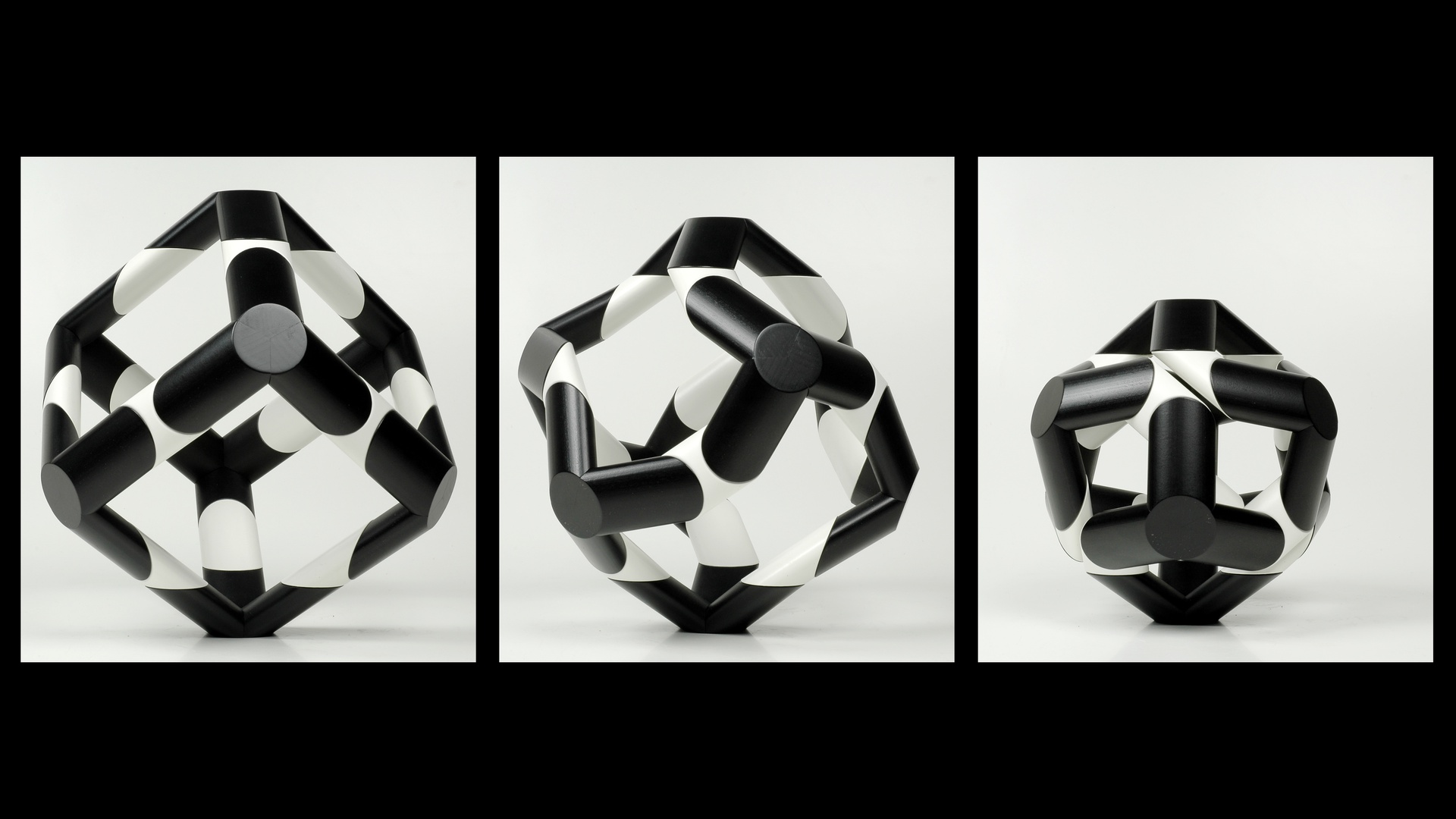
Transforming Cube
Slinky, the metal spring toy that walks down stairs, has been the key inspiration of the author. When squeezed, the transforming cube forms a cylinder with an ellipse as cross section. The endings remain circular, parallel or anti-parallel. The parts are assembled to make flexible structures. They led to the discovery of several transforming polyhedra.
Author: Xavier De Clippeleir
변형되는 정육면체
슬링키(Slinky), 혹은 매직스프링 이라고 알려진 장난감이 이 디자인에 가장 큰 영감을 주었습니다. 이 변형되는 정육면체는 압력을 받을 시 타원형의 단면을 지닌 원통으로 바뀌게 됩니다. 끝부분의 단면들은 평형, 혹은 역평형 형태의 원형을 유지합니다. 유연한 구조 덕분에 여러가지 변형되는 다면체를 발견할 수 있게 되었습니다.
만든 이: Xavier De Clippeleir
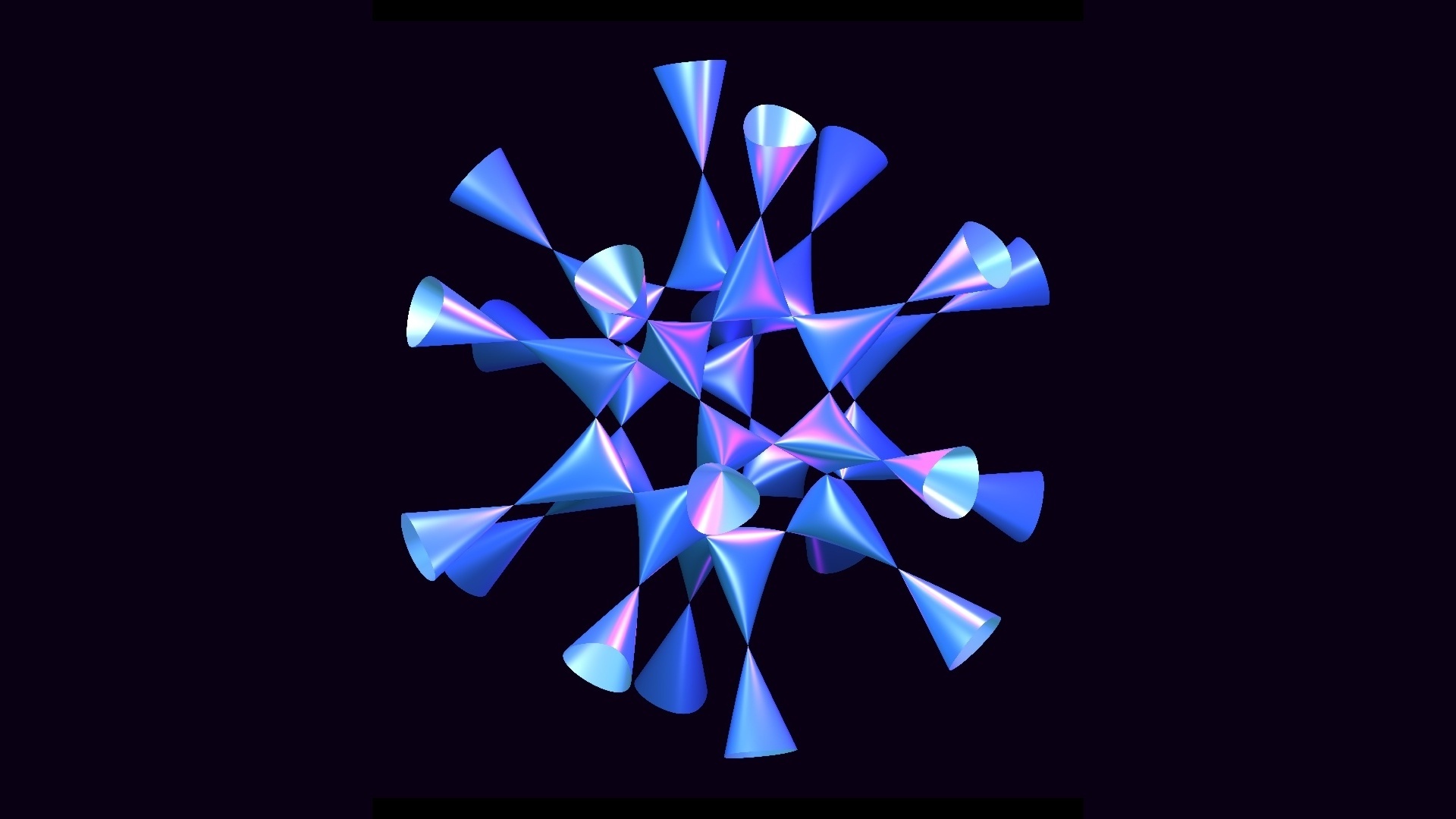
Barth Sextic
This surface of degree 6 (sextic) was constructed by Wolf Barth in 1996. Altogether, it has 65 singularities when also counting the 15 invisible ones which are infinitely far away. 65 is the maximum possible number of singularities on a sextic as shown in 1997 by Jaffe and Ruberman.
Barth's construction was a big surprise: For a long time geometers believed that a surface of degree 6 cannot have more than 64 singularities.
Author: Oliver Labs
바스(Barth)의 6차곡면
6차 방정식으로 정의된 이 곡면은 1996년 Wolf Barth로부터 만들어졌습니다. 총 65개의 특이점을 가지고 있는데 그 중 15개는 무한히 멀리 떨어져 있어 보이지 않습니다.1997년에 Jaffe와 Ruberman이 6차 곡면이 가질 수 있는 특이점의 최대 개수가 65개임을 보였습니다.
Barth가 처음 이 곡면을 만들었을 때 많은 수학자들이 놀랐습니다. 왜냐하면 기하학자들은 6차 곡면은 많아봐야 64개의 특이점을 가질 것이라고 믿었기 때문입니다.
만든 이: Oliver Labs
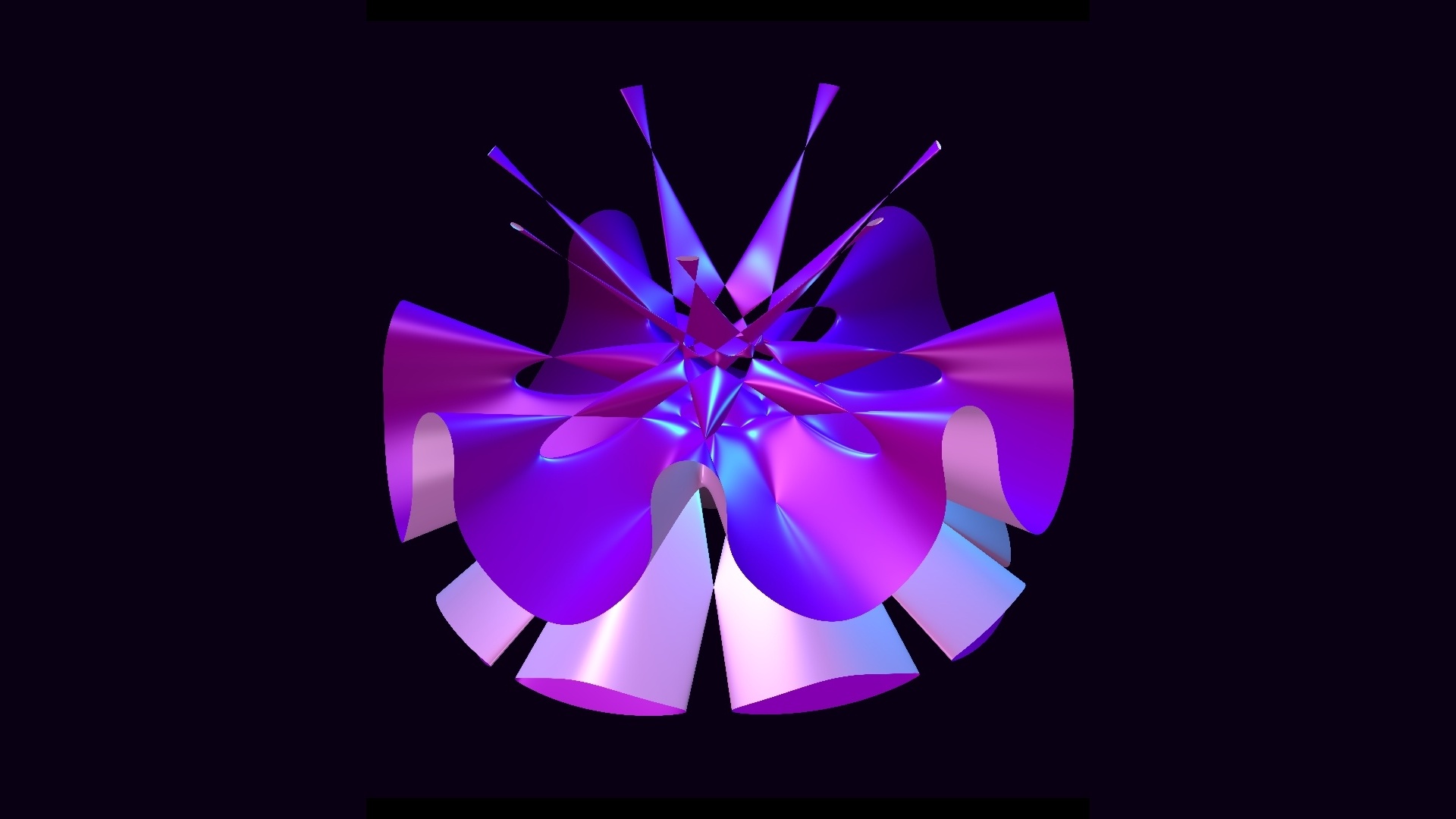
Labs Septic
In 2004, while writing his Ph.D. thesis at Mainz, Oliver Labs constructed a surface of degree 7 (septic) with 99 singularities. Since 1997 one knows for surfaces of degree 6 that the maximum possible number of singularities is 65. In degree 7 there is a result of A.N. Varchenko from 1982 which tells us that there cannot be more than 104 singularities. In 1992, Chmutov constructed a septic with 93 singularities which was the world record at that time. Since Labs' construction, this world record has been 99. It is open if septics can have 100, 101, ... , 104 singularities.
The Labs Septic has the symmetry of a regular 7-gon. However, similar to Duco van Straten's computation for the sextics, one can compute that there is indeed a 5-parameter family of septics with 99 singularities. For the construction of the septic the computer algebra software Singular was used. It is developed at TU Kaiserslautern and very well suited for working with singular algebraic surfaces.
Author: Oliver Labs
Labs의 7차곡면
2004년에 Oliver Labs이 박사 학위 논문을 쓰던 중에 99개의 특이점을 가지는 7차 곡면을 만들었습니다. 1997년 이후로 6차 곡면이 가질 수 있는 특이점의 최대 개수가 65개임이 알려져 있었습니다. 1982년에 A.N. Varchenko가 7차 곡면은 많아야 104개의 특이점을 가진다는 것을 증명했습니다. 1992년에 Chmutov는 93개의 특이점을 가지는 7차 곡면을 만들었고 이것은 그 당시 최고 기록이었습니다. 현재까지는 Labs이 만든 이 곡면이 가장 많은 특이점을 가지는 7차 곡면으로 알려져 있습니다. 7차 곡면이 특이점을 100, 101, …, 104개를 가질 수 있는지 여부는 아직 증명되지 않았습니다.
Labs의 7차곡면은 정칠각형의 대칭성을 가집니다. 참고로 5개의 매개 변수를 가지면서 99개의 특이점을 가지는 곡면들의 모임도 있습니다. 이 곡면은 독일에 있는 TU Kaiserslautern 에서 개발한 컴퓨터 대수 프로그램인 Singular를 이용해서 만들어졌습니다. 이 프로그램은 특이점을 가지는 대수곡면을 연구하는데 매우 유용합니다.
만든 이: Oliver Labs
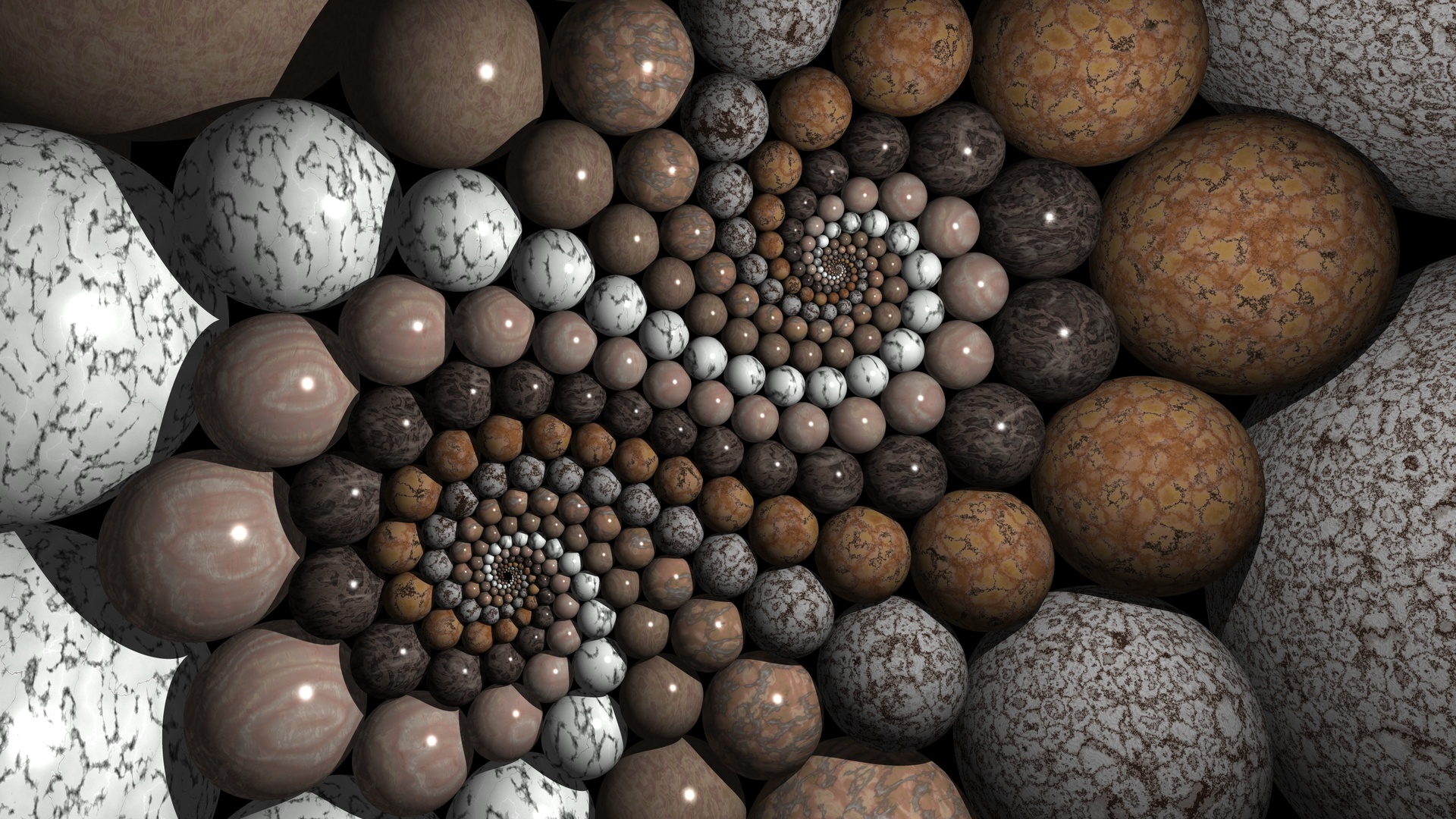
Doyle Spiral
Doyle Spirals are a particular case of circle packing: each circle is surrounded with 6 tangent circles. When the parameters are well chosen (and this is the hard stuff), this circle packing can tile the plane. Applying to this tiling geometric transformations preserving the tangency property, one can create elegant patterns.
This work was initiated while looking at the beautiful and challenging images created by Jos Leys.
Author: Francesco De Comité
Doyle 나선
Doyle 나선은 모든 원이 언제나 6개의 접원으로 둘러 쌓여져 있는 특수한 원 채우기의 일종입니다. 쉽진 않지만, 적당한 변수 선택을 통해 이 방법으로 면을 채울 수 있습니다. 접원 조건을 유지한 채로 이 나선에 여러 기하학적 변형을 적용시키면, 아름다운 무늬들을 만들 수 있습니다.
지금 보시는 이 작품은 Jos Leys의 아름답고 난해한 이미지들을 감상하던 중 만들어지게 되었습니다.
만든 이: Francesco De Comité

Boy Surface
The Boy surface is generated by adding a moebius strip with a disk attached to its boundaries to a closed surface. The fact that this is made possible at all was proved by Werner Boy. The Boy surface intersects itself, but otherwise looks smooth in each of its points.
The version shown here is characterized by its mean curvature being as small as possible. It has 'no unnecessary bumps' in this sense. Here, you see the most 'beautiful' possible realization of Boy surface in a mathematically precise sense. This is a parametrization of Boy surface by Robert Bryant and Robert Kusner.
The image is based on a bullet panorama which Paul Debevec generated from photos of a church in San Francisco. The scene was compiled in jReality, the image itself was calculated with Sunflow. Promoted by the DFG-Research Centre Matheon.
Author: Ulrich Pinkall
보이(Boy) 곡면
Boy 곡면은 원판의 가장자리에 뫼비우스 띠를 꿰매어 얻은 곡면을 매개화하여 얻을 수 있는 비가향 곡면(non-orientable) 곡면입니다. 1901년 Werner Boy가 발견한 이 곡면은 (자기 교차는 가지지만) 특이점이 없는 사영평면의 한 모델입니다.
이 그림은 곡면의 평균 곡률이 가능한 작도록 하여 얻었습니다. 이런 점에서 불필요한 돌출부가 없습니다. 지금 당신은 수학적으로 정확하면서도 가장 아름답게 구현된 Boy 곡면을 보고 있습니다.
이 그림은 Robert Bryant와 Robert Kusner가 Boy 곡면을 매개화한 것으로, Paul Debevec이 샌프란시스코의 한 교회의 사진으로 부터 만든 bullet panorama를 기반으로 합니다. 그림의 바탕은 jReality를 이용하여 컴파일되었고 그림 자체는 Sunflow를 이용하여 계산되었습니다.
만든 이: Ulrich Pinkall

Süss
Love-letter
It can't go on and on like this!
This what we have we have to keep.
When we'll meet,
Something must be.
Together singularity.
What`s up on singularity?
For sure no platitudes.
Because what's singularity,
Is not wearing down so easily.
On a park bench in Grunewald
In two to face the rain,
Attempts in vain. Girl, take heart! Write me a card!
Yours, Bertie! (Erinner Singularity).
Poem by Joachim Ringelnatz
The passion of love is generally connected to the emotional power of a ''singularity''. This connection appears in many forms of art.
Author: Herwig Hauser
달콤함
연애편지
언제까지 이렇게 갈 수는 없어요!
우리가 지켜야 할 것이 있죠,
우리가 만나면,
무언가 있어야 해요.
함께하는 특이점이.
특이점에는 무엇이 있을까요?
따분한 이야기는 없을 거에요
왜냐하면 특이점은,
쉽게 지치지 않으니까요.
Grunewald 공원 벤치에 앉아
둘이 그저 비와 마주앉아 있기는
따분하지 않나요. 용기 내요, 소녀여! 편지해 주오!
베티에게 (특이점을 기억하길!).
Joachim Ringelnatz 저
''특이점''이 보여주는 감성의 울림은 종종 사랑의 열정과 매우 닮아 있고, 이는 매우 예술적으로 나타나기도 합니다.
만든 이: Herwig Hauser
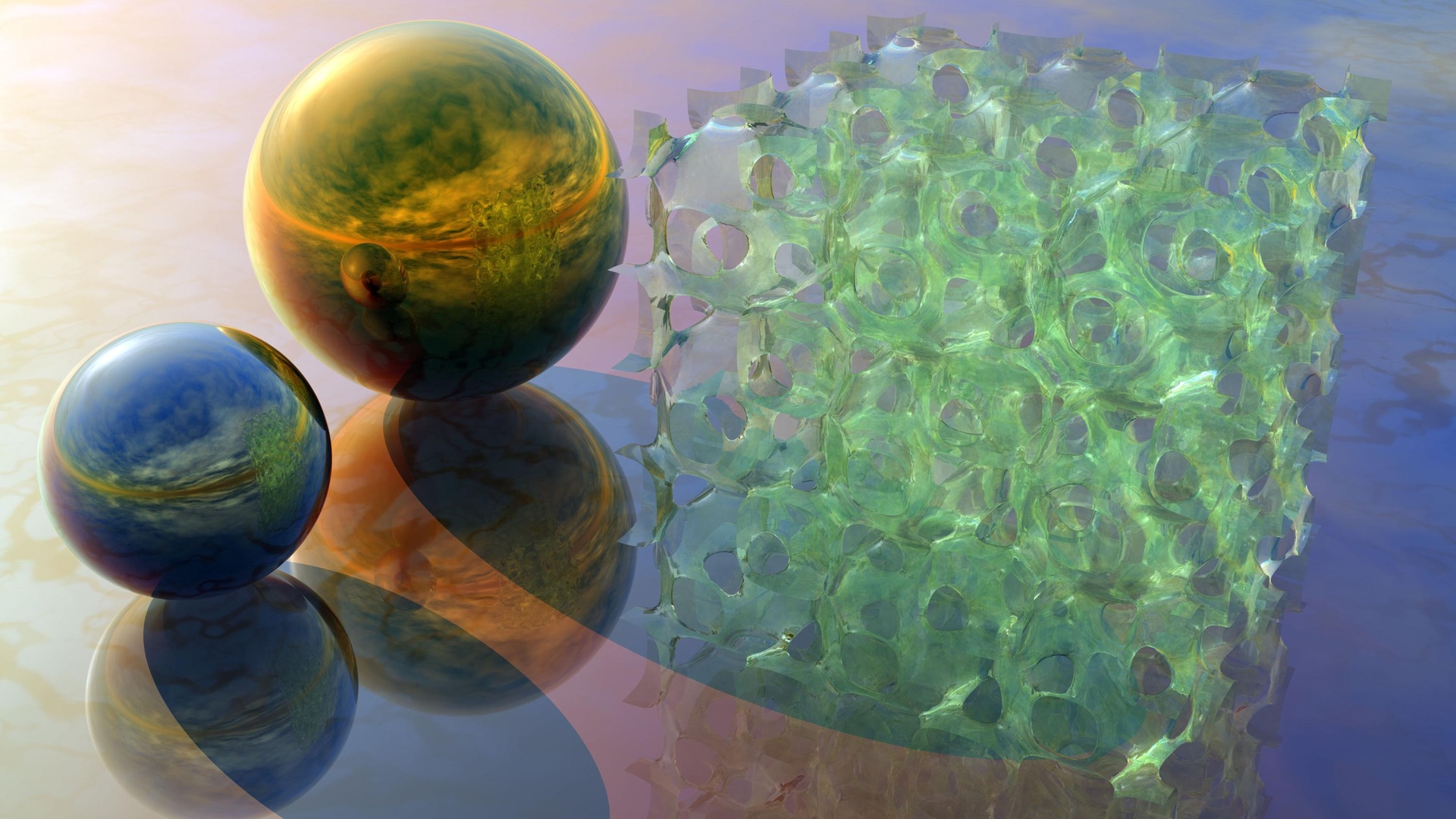
A Triply-Periodic Level Surface
The green-tinted surface pictured here has three orthogonal translational symmetries. It is the level-surface given by the trigonometric equation:
4 (cosx cos y + cosy cosz + cosz cosx) - 3 cosx cosy cosz = -2.4
A unit cell may be viewed as a central chamber with tubes to the corners and faces of the cube. This surface closely approximates the minimal P-Surface discovered in 1880 by Karl Hermann Amandus Schwartz (who was a Professor at Halle, Goettingen, and Berlin). Recently it has been investigated by material scientists, who use it and related surfaces to model so-called block- copolymers. The original model was taken from David A. Hoffman. This was textured, placed in a scene that we feel adds to the beauty of the object and rendered in Bryce.
Author: Luc Benard
3중 주기를 갖는 등위 곡면(A Triply-Periodic Level Surface)
그림 중에 옅은 녹색의 곡면은 세 가지의 직교 평행이동 대칭을 가지고 있는데, 다음의 삼각 방정식에 의해 주어지는 등위 곡면(level surface)입니다:
4 (cosx cos y + cosy cosz + cosz cosx) - 3 cosx cosy cosz = -2.4
면과 모서리 부분이 튜브로 연결 되어있는 정육면체가 둘러싸고 있는 공간을 곡면대칭의 기본단위로 생각할 수 있습니다. 이 곡면은 할레대학, 괴팅켄대학 및 베를린 대학의 교수였던 칼 헤르만 아만두스 슈워츠에 의해 1880년에 발견된 최소 P-곡면과 매우 유사합니다. 최근 혼성중합체라는 것을 모델링하기 위해 관련 곡면들을 조사하는 재료과학자들이 자세히 연구하고 있습니다.
데이비드 호프만(David A. Hoffman)이 그림의 원형을 제시하였는데, 보다 아름답게 표현하기 위해 질감을 조정하고 배경을 입혔으며 최종적으로 Bryce를 이용해 만들었습니다.
만든 이: Luc Benard
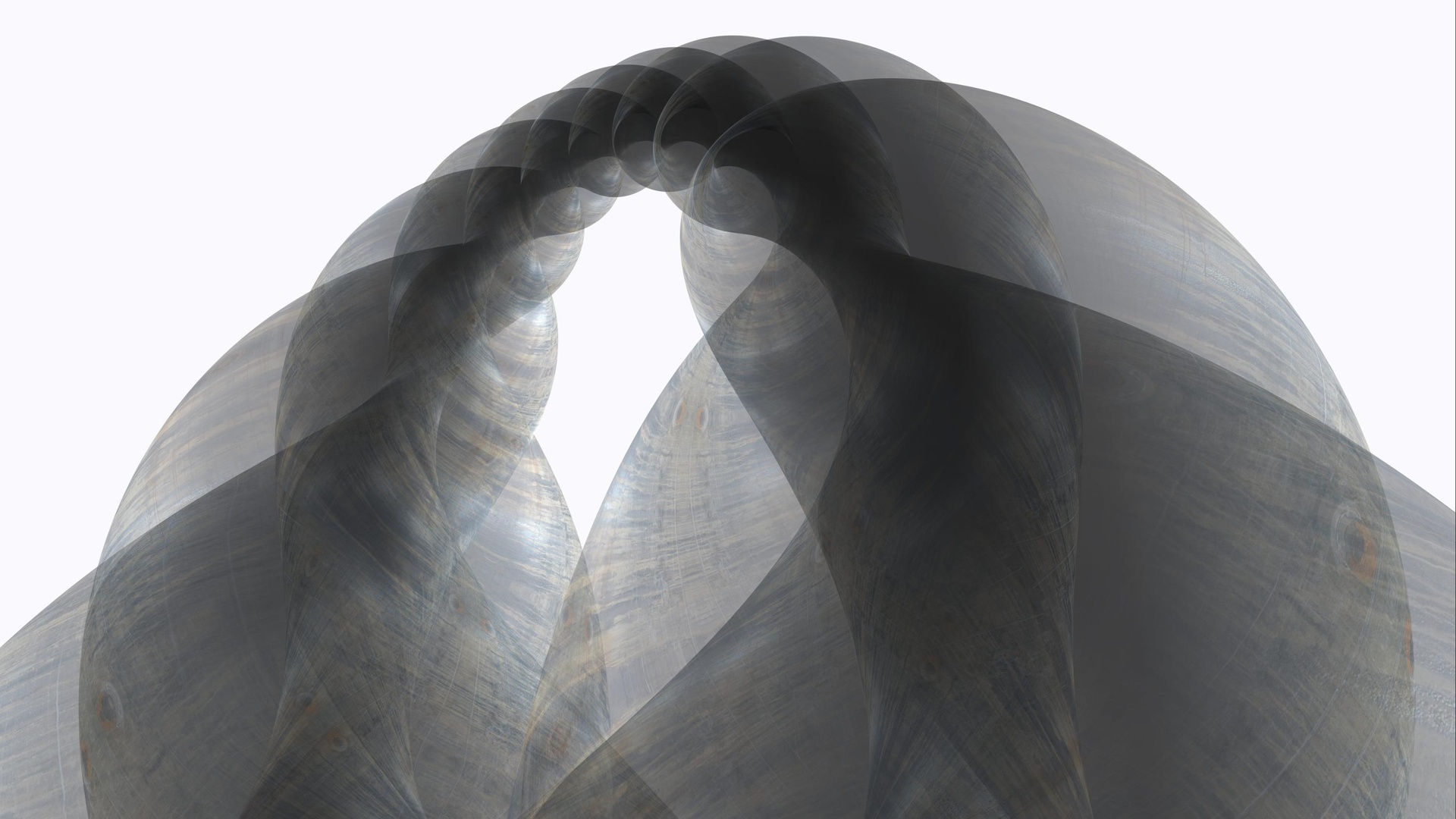
Twizzle Torus
The Twizzle Torus is an annular surface with a constant mean curvature in the three-dimensional sphere, a space curved in itself. To make it visible it must first be projected into our flat space. Luckily, this is enabled such that basic shape features can be maintained. In the three-dimensional sphere where it belongs to it has a screw symmetry which can still be surmised during projection.
The Twizzle Torus is only a comparatively simple example in an endless hierarchy of increasingly complex annular surfaces with similar curvature features.
The surface was developed by the GeometrieWerkstatt Tübingen using XLab software.
Author: Nicholas Schmitt
나선형 원환면(Twizzle Torus)
나선형 원환면은 굽은 공간인 3차원 구에서 일정한 평균 곡률을 가지는 원환 형의 곡면입니다. 이를 육안으로 보기 위해서는 평면 공간으로 사영시켜야 합니다. 다행히 나선형 원환면의 기본적인 특성을 유지하면서 사영시킬 수 있습니다. 나선형 원환면은 3차원 구에서 나선 대칭인데, 사영시키는 과정에서도 여전히 나선 대칭임을 예상할 수 있습니다.
나선형 원환면은 유사한 곡률의 성질을 가지면서 점점 복잡해지는 원환형 곡면들의 끝없는 계층(hierarchy) 중에서 유일하게 비교적 간단한 예입니다.
이 곡면은 Xlab이라는 소프트웨어를 사용해서 GeometrieWerkstatt Tübingen에서 의해 개발하였습니다.
만든 이: Nicholas Schmitt
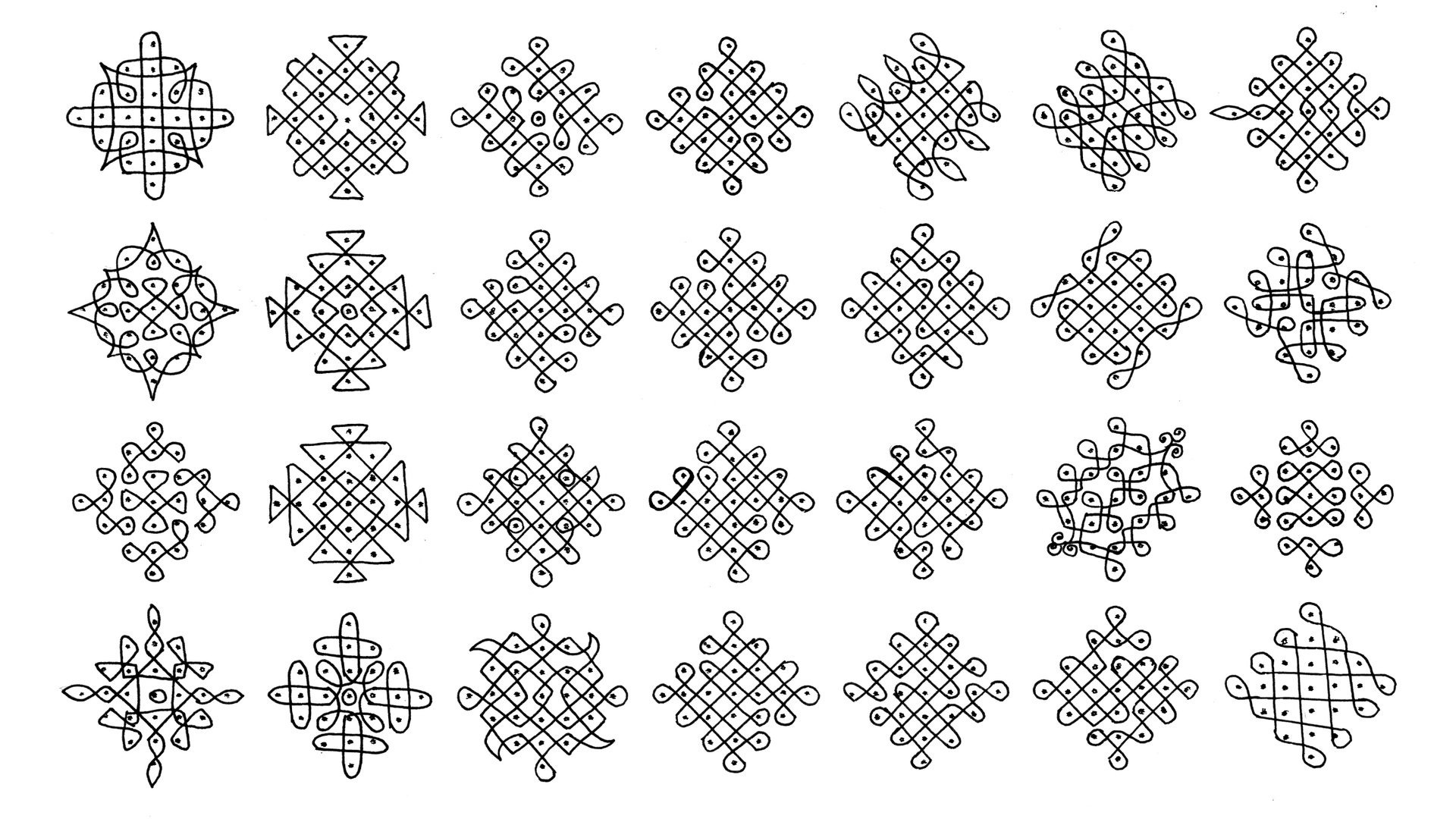
Suzhi Kolam
Kolams are decorative geometrical patterns that adorn the entrances of households and places of worship especially in South India (Tamil Nadu). It is a belief that laying kolam brings wealth and prosperity to home, business, etc. On Scientific basis, laying kolam is a good exercise for body, fingers and mind. It improves arithmetic knowledge and imagination power. While joining dots we concentrate our mind and it improves the strength of thinking power.
Dots (called pulli) are arranged in rhombic, square, triangular, or free shapes, and a single, uninterrupted linear or curvilinear line (called the kambi), intertwines the dots. There are no written or verbally stated rules.
Kolam drawing can be treated as a special kind of graph with the crossings considered as vertices and the parts of the kambi between vertices treated as edges. The only restriction is that unlike in a graph, these edges cannot be freely drawn as there is a specific way of drawing the kolam. The single kambi kolam will then be an Eulerian graph with the drawing starting and ending in the same vertex and passing through every edge of the graph only once.
Author: Brunda Alagarsamy
Suzhi Kolam
Kolam은 주로 인도 남부지역에서 가정이나 사원의 입구 장식에 쓰이는 기하학적 무늬입니다. 주민들은 Kolam이 부와 풍요를 가져다준다고 믿고 있습니다. 과학적으로 봤을때, Kolam 장식을 하는 일은 우리의 손가락과 몸 뿐만 아니라 우리의 정신에도 좋은 운동이 됩니다. 정신을 집중하여 점들을 연결시키는 일은 우리의 상상력과 생각하는 힘을 길러줍니다.
Pulli라고 불리는 점들은 삼각형, 사각형, 또는 자유로운 형태로 퍼져있으며, Kambi라는 끊기지 않는 하나의 선으로 뒤섞이게 됩니다. Kolam을 만드는 정해진 규칙은 존재하지 않습니다.
Kambi의 교차점을 꼭짓점으로, 그 사이의 선들을 모서리라고 생각하면, Kolam은 특별한 그래프의 모습으로 생각될 수 있습니다. 일반 그래프들 과 달리 Kolam의 모서리들은 자유롭게 그려질 수 없다는 제한이 있습니다만, 그것만 제외한다면 Kolam은 시작점과 끝점이 같은 한붓 그리기가 가능한 오일러 그래프의 일종이 됩니다.
만든 이: Brunda Alagarsamy